



|

|

|
|
Huckleberry, Botanic Regional Preserve
|
|
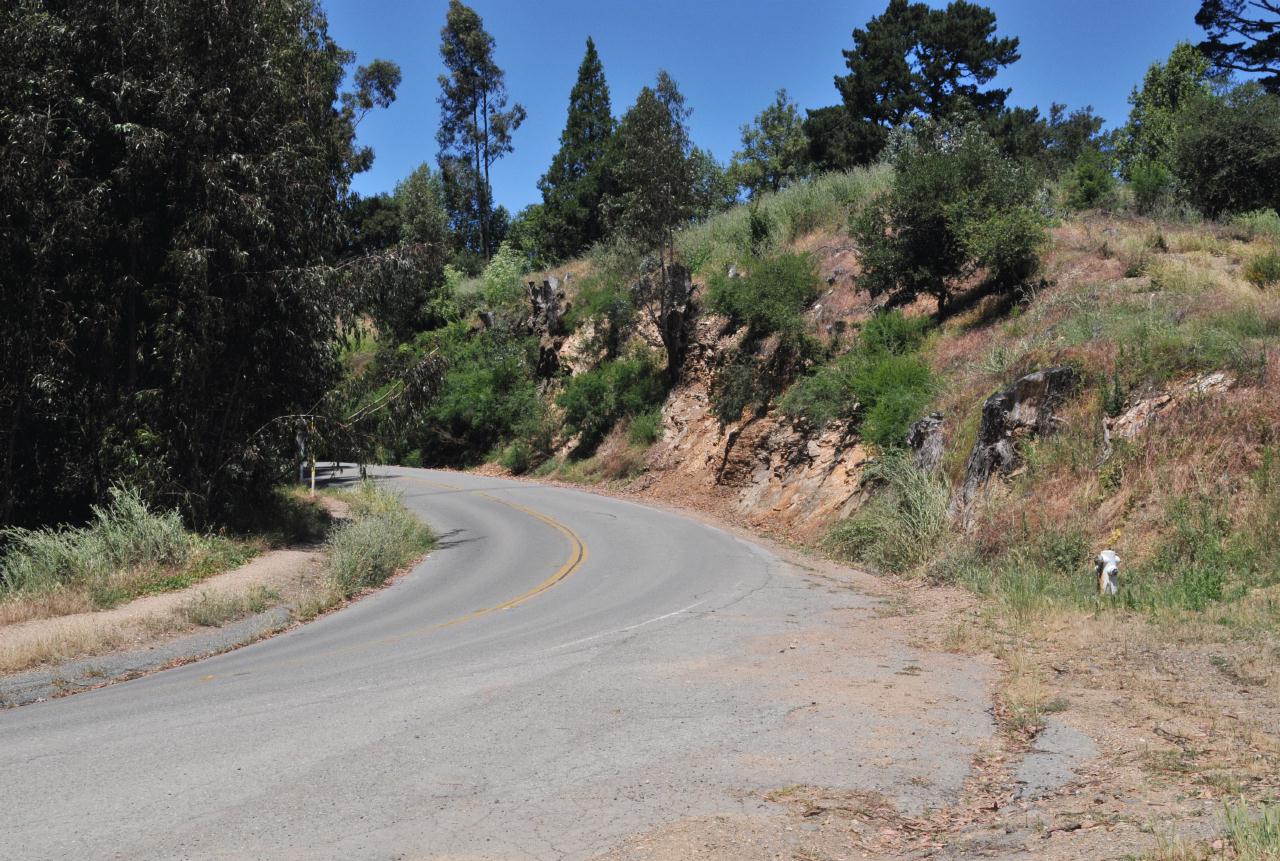 The entry to the park is just to the left when traveling north and just to the right when traveling south. Keep an eye peeled as the road rounds a large curve. Here we looked to the right from the entry gate with yeilded a view of the road looking back down it to the south.
Huckleberry Botanic Regional Preserve • East Bay Regional Parks District • Skyline Boulevard, Oakland, California • (Photo posted Tuesday 9 November 2010) • (Photo taken 13:22:44 Saturday 12 June 2010) • © 2010 Bryan Costales 
 #132244_6148BCX #132244_6148BCX
Add a comment or report a mistake
|
|
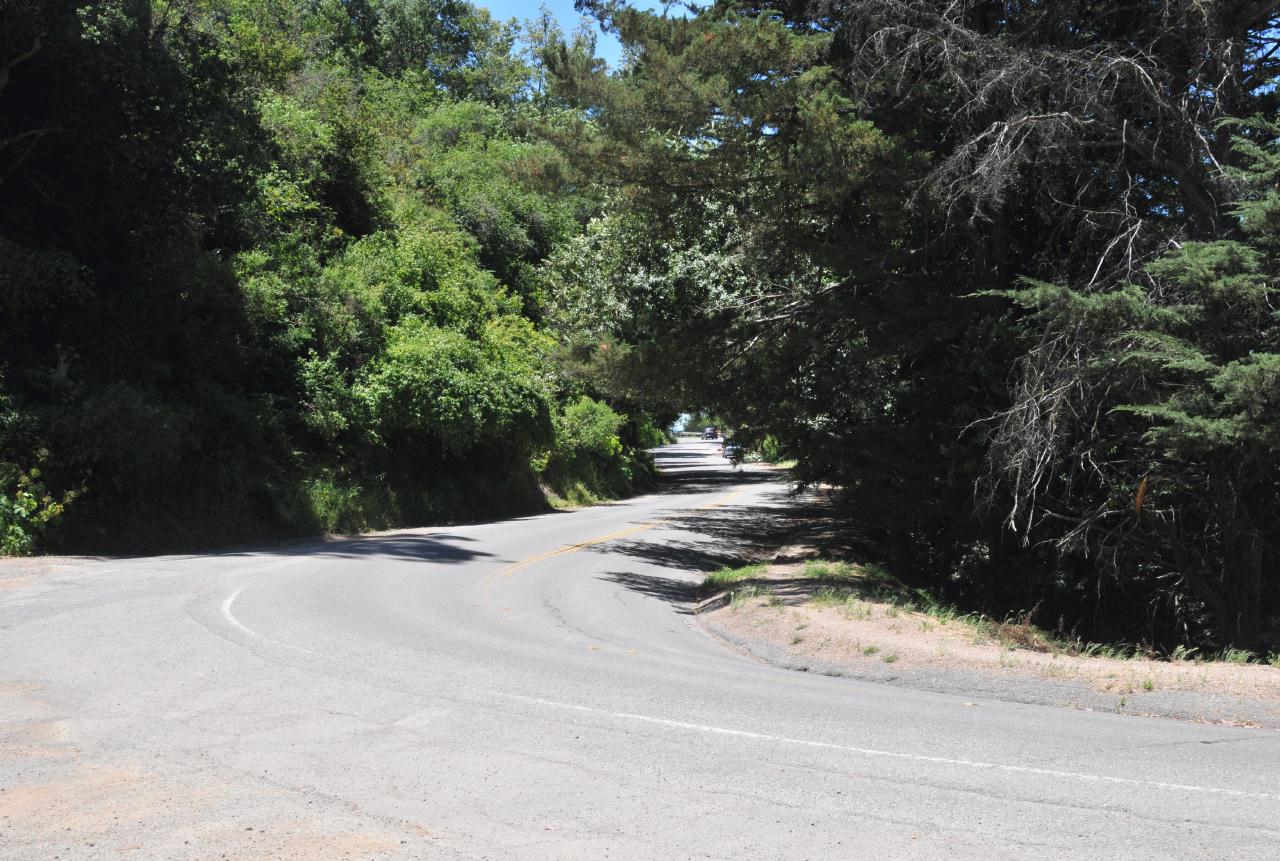 Because the preserve lay at the apex of a sweeping curve in the road, visibility was good for pulling back out onto Skyline Boulevard.
Huckleberry Botanic Regional Preserve • East Bay Regional Parks District • Skyline Boulevard, Oakland, California • (Photo posted Tuesday 9 November 2010) • (Photo taken 13:22:46 Saturday 12 June 2010) • © 2010 Bryan Costales 
 #132246_6149BCX #132246_6149BCX
Add a comment or report a mistake
|
|
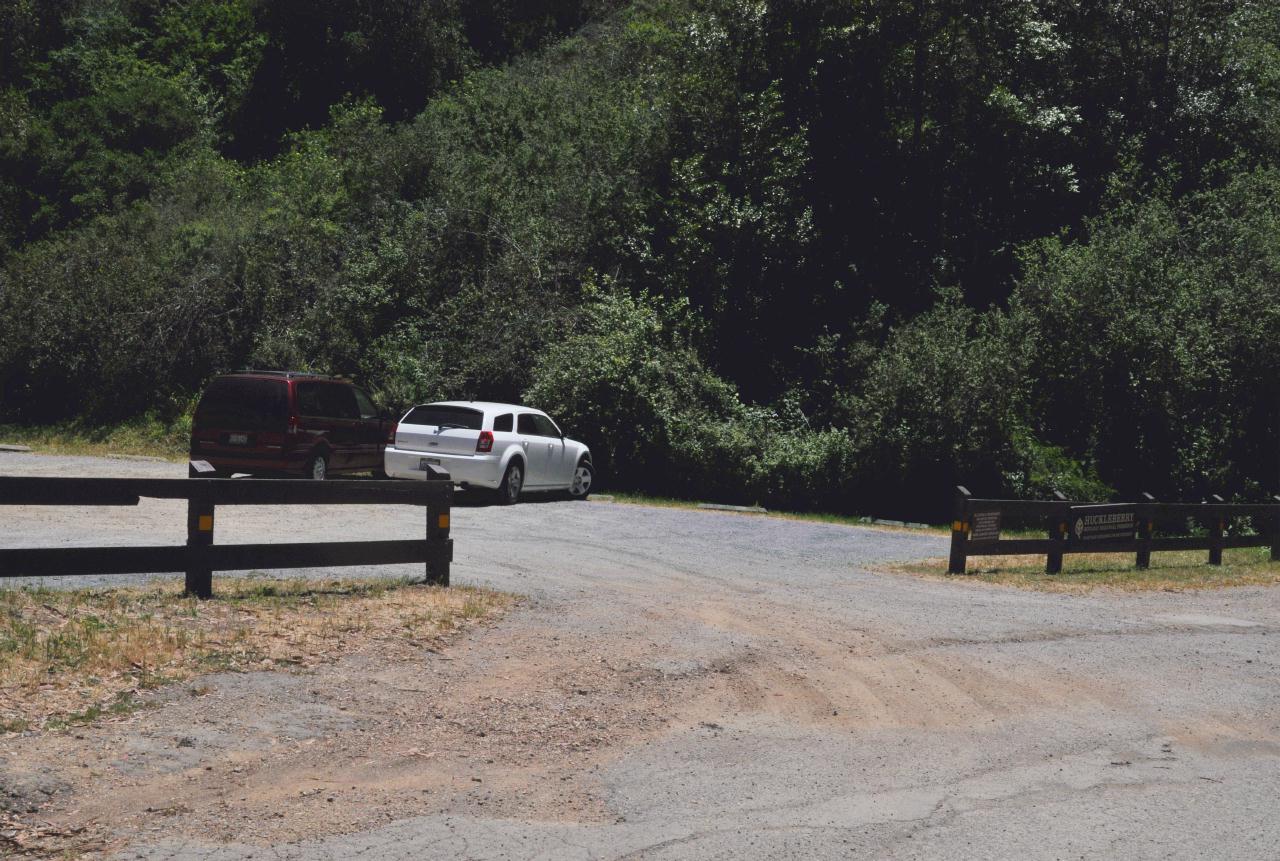 Entry to the preserve was free. A large gravel parking lot provided room for a dozen or so cars. It did not appear possible to access the preserve via public transportation. Later research showed that one could access the preserve using the AC Transit #305 bus, that only ran on Tuesdays and Thursdays.
Huckleberry Botanic Regional Preserve • East Bay Regional Parks District • Skyline Boulevard, Oakland, California • (Photo posted Tuesday 9 November 2010) • (Photo taken 13:23:00 Saturday 12 June 2010) • © 2010 Bryan Costales 
 #132300_6126BCX #132300_6126BCX
Add a comment or report a mistake
|
|
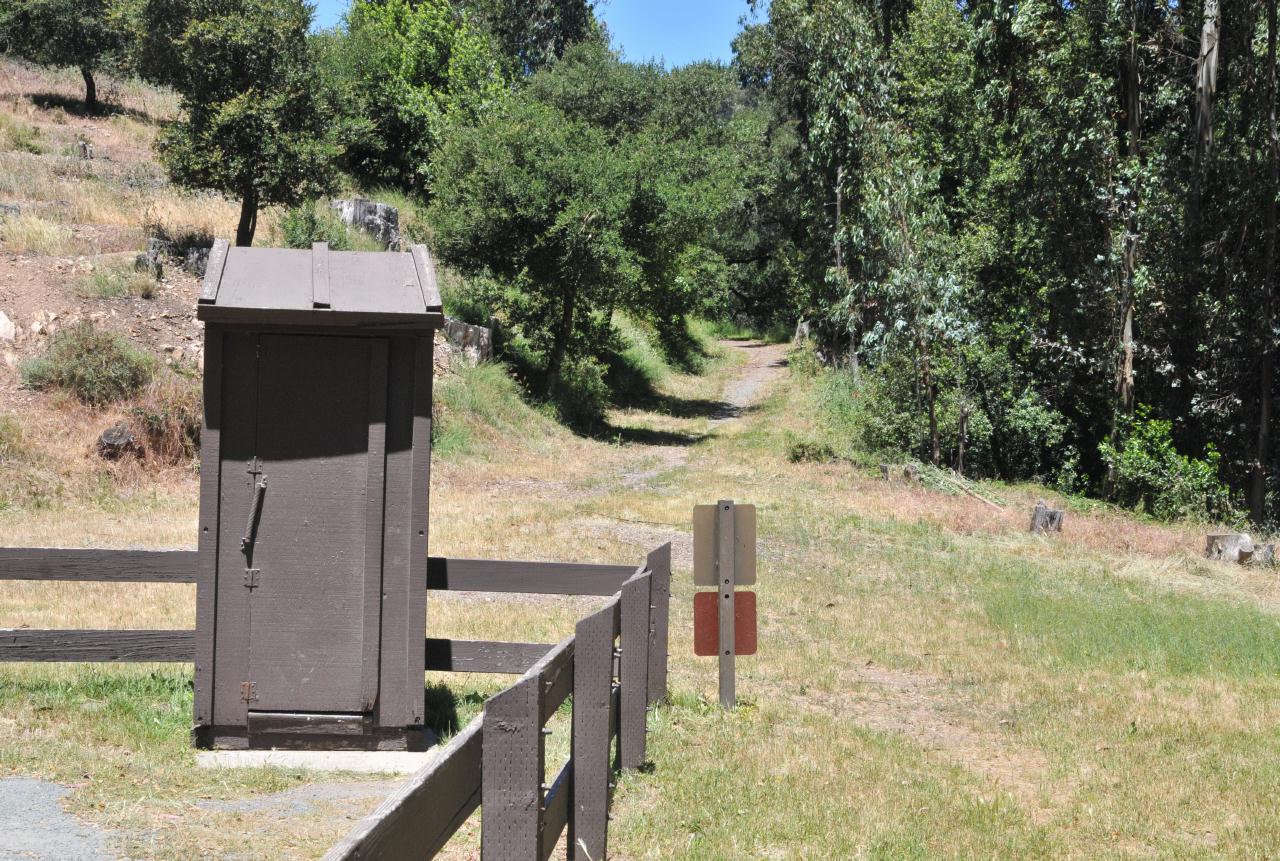 The only restroom was a single wooden outhouse at the corner of the parking lot. On this day it had shown signs of recent cleaning.
Huckleberry Botanic Regional Preserve • East Bay Regional Parks District • Skyline Boulevard, Oakland, California • (Photo posted Tuesday 9 November 2010) • (Photo taken 13:23:26 Saturday 12 June 2010) • © 2010 Bryan Costales 
 #132326_6152BCX #132326_6152BCX
Add a comment or report a mistake
|
|
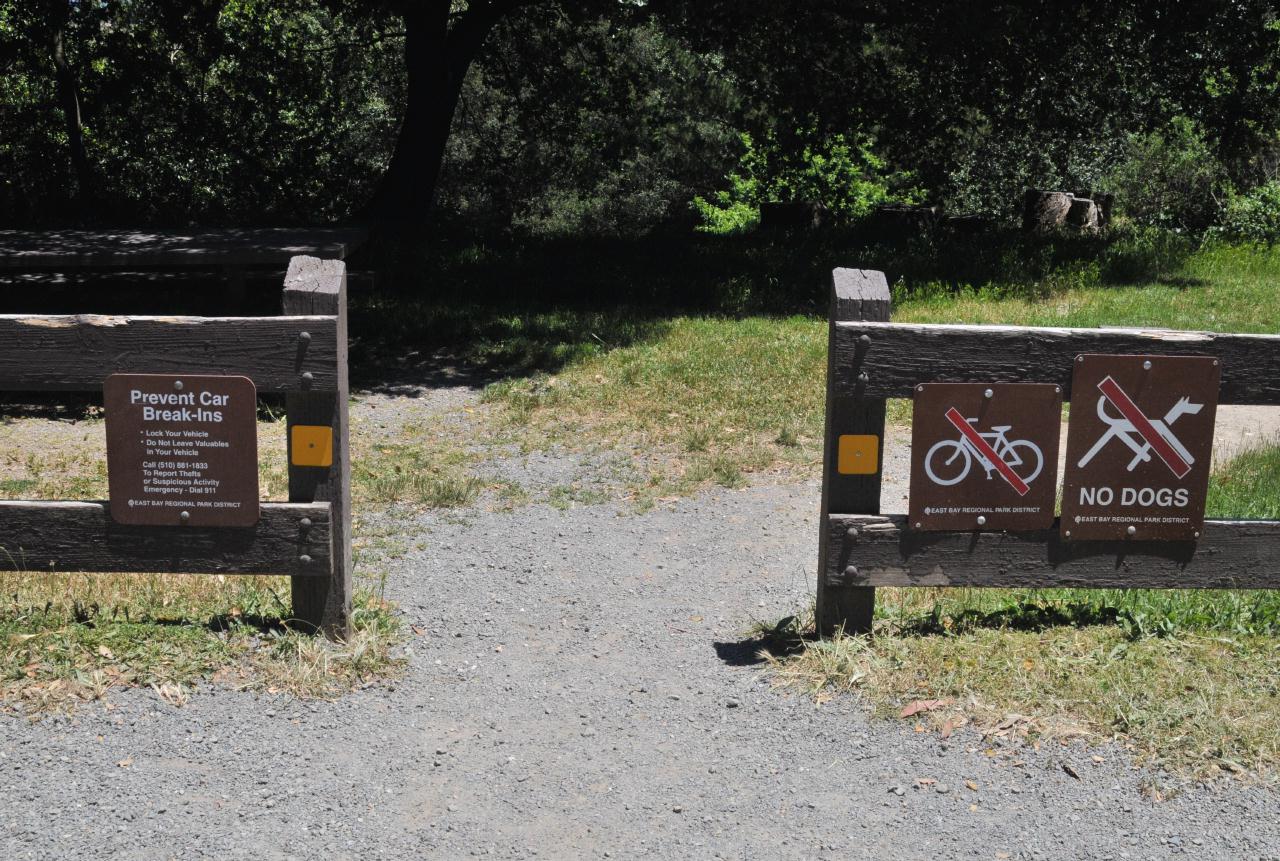 Entry was at the back of the parking lot. The gate was posted with signs prohibiting bicycles and dogs. Another sign warned of the risk of "Car Break-Ins" and provided hints for preventing loss.
Huckleberry Botanic Regional Preserve • East Bay Regional Parks District • Skyline Boulevard, Oakland, California • (Photo posted Tuesday 9 November 2010) • (Photo taken 13:23:32 Saturday 12 June 2010) • © 2010 Bryan Costales 
 #132332_6151BCX #132332_6151BCX
Add a comment or report a mistake
|
|
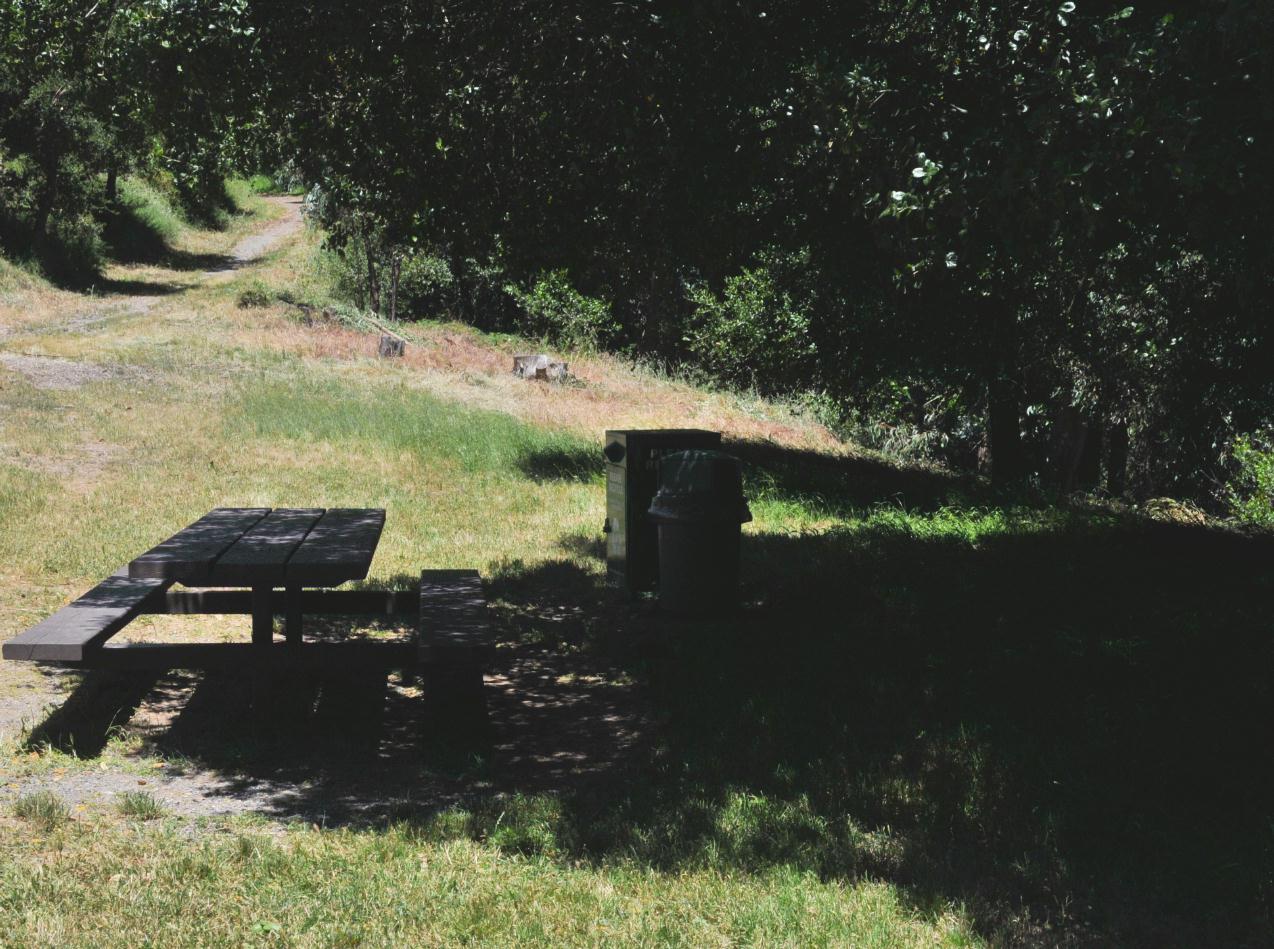 A single picnic table was available for day use. It was in good repair and included a metal container to accept hot coals from a barbecue.
Huckleberry Botanic Regional Preserve • East Bay Regional Parks District • Skyline Boulevard, Oakland, California • (Photo posted Tuesday 9 November 2010) • (Photo taken 13:23:34 Saturday 12 June 2010) • © 2010 Bryan Costales 
 #132334_6153BCX #132334_6153BCX
Add a comment or report a mistake
|
|
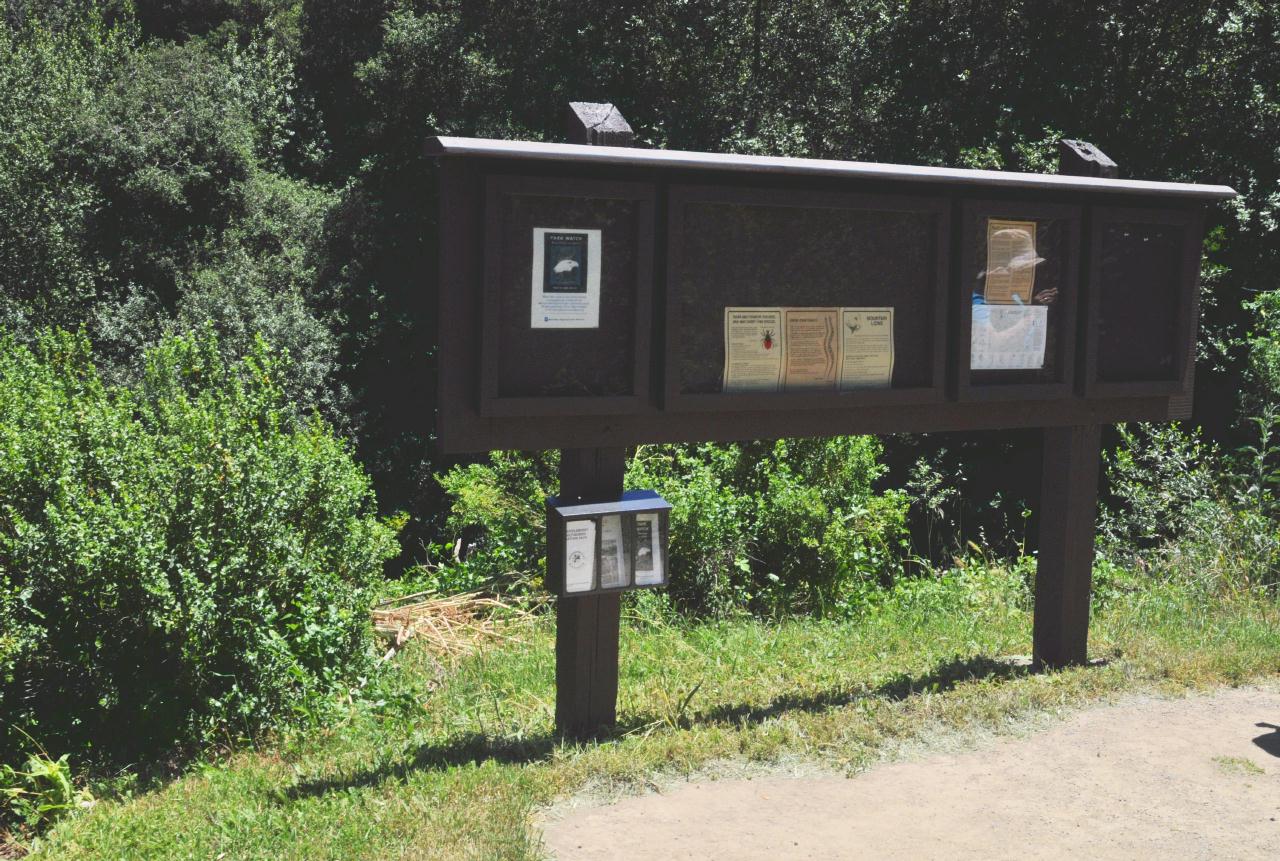 The stand provided two key brochures. A map and history entitled "Huckleberry Botanical Regional Preserve" and a guide to the nature walk called, "Huckleberry Self-Guided Nature Path." The latter included a full description of the botanical item indicated by numbered signs found alongside the path during the walk.
Huckleberry Botanic Regional Preserve • East Bay Regional Parks District • Skyline Boulevard, Oakland, California • (Photo posted Tuesday 9 November 2010) • (Photo taken 13:23:42 Saturday 12 June 2010) • © 2010 Bryan Costales 
 #132342_6154BCX #132342_6154BCX
Add a comment or report a mistake
|
|
 The self-guided walk began at the top of a valley located in the classically dry east bay hills above Oakland.
Huckleberry Botanic Regional Preserve • East Bay Regional Parks District • Skyline Boulevard, Oakland, California • (Photo posted Tuesday 9 November 2010) • (Photo taken 13:24:26 Saturday 12 June 2010) • © 2010 Bryan Costales 
 #132446_6157BCX #132446_6157BCX
Add a comment or report a mistake
|
|
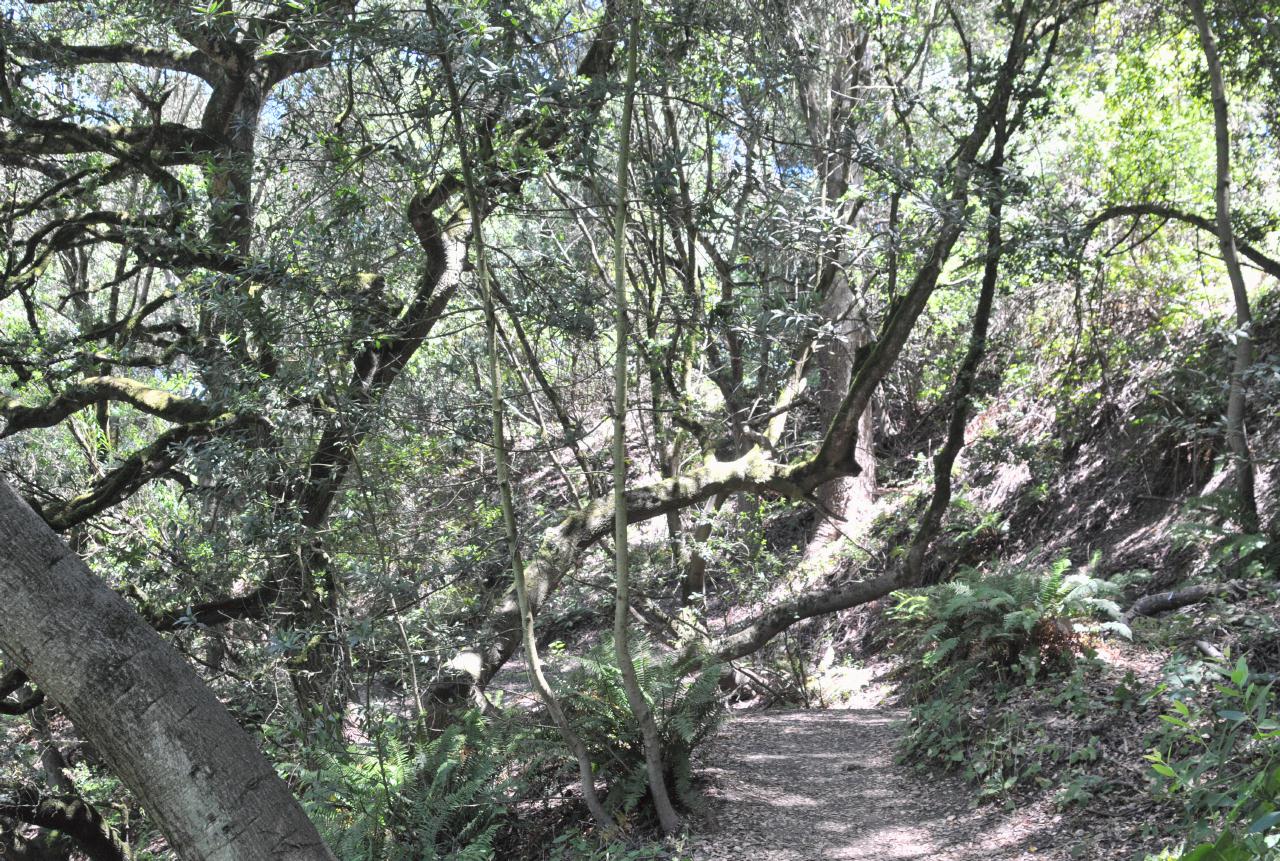 The self-guided trail soon descended into the tangles of a valley forest. The trail was wide and clear and ran below these trees.
Huckleberry Botanic Regional Preserve • East Bay Regional Parks District • Skyline Boulevard, Oakland, California • (Photo posted Tuesday 9 November 2010) • (Photo taken 13:29:10 Saturday 12 June 2010) • © 2010 Bryan Costales 
 #132910_6161BCX #132910_6161BCX
Add a comment or report a mistake
|
|
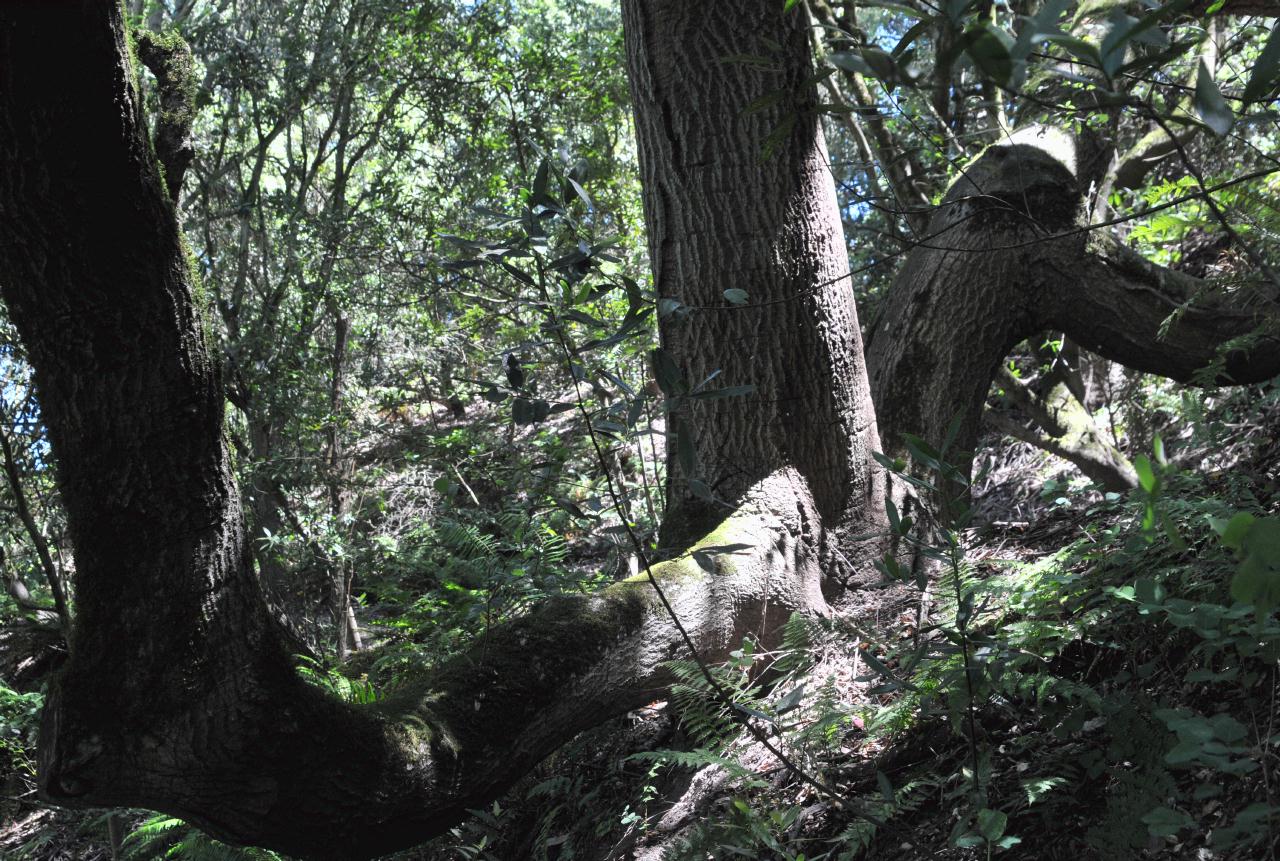 Mature older trees lined the path. Many with powerfully wild trunks that spread as if arms open to envelope us.
Huckleberry Botanic Regional Preserve • East Bay Regional Parks District • Skyline Boulevard, Oakland, California • (Photo posted Tuesday 9 November 2010) • (Photo taken 13:31:04 Saturday 12 June 2010) • © 2010 Bryan Costales 
 #133104_6163BCX #133104_6163BCX
Add a comment or report a mistake
|
|
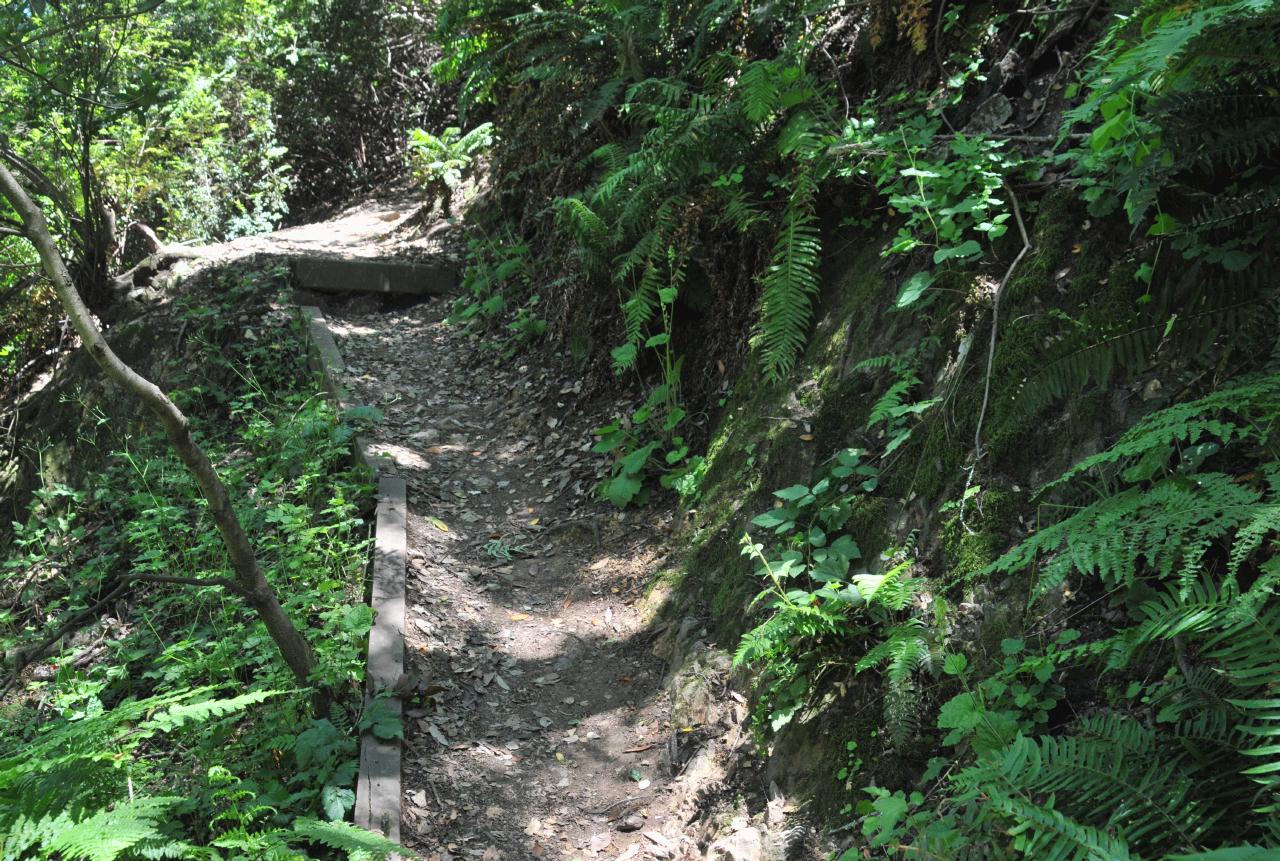 The trail soon narrowed and became uneven. This self-guided trail turned out not to be suitable for the disabled. It later included narrow s-curves and and stairs.
Huckleberry Botanic Regional Preserve • East Bay Regional Parks District • Skyline Boulevard, Oakland, California • (Photo posted Tuesday 9 November 2010) • (Photo taken 13:35:30 Saturday 12 June 2010) • © 2010 Bryan Costales 
 #133530_6166BCX #133530_6166BCX
Add a comment or report a mistake
|
|
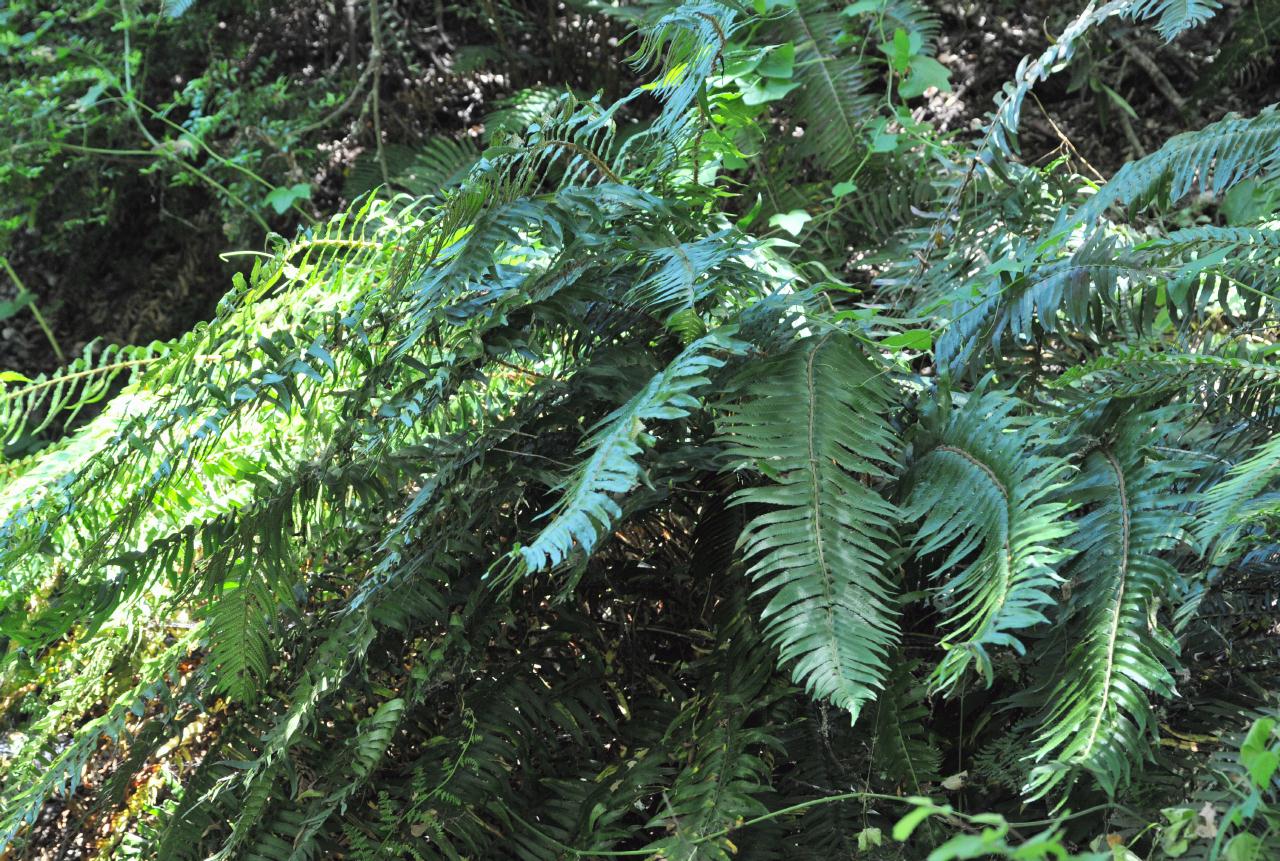 Western Sword Fern (Polystichum munitum) bordered parts of the trail, lending it a somewhat tropical feeling.
Huckleberry Botanic Regional Preserve • East Bay Regional Parks District • Skyline Boulevard, Oakland, California • (Photo posted Tuesday 9 November 2010) • (Photo taken 13:36:06 Saturday 12 June 2010) • © 2010 Bryan Costales 
 #133606_6167BCX #133606_6167BCX
Add a comment or report a mistake
|
|
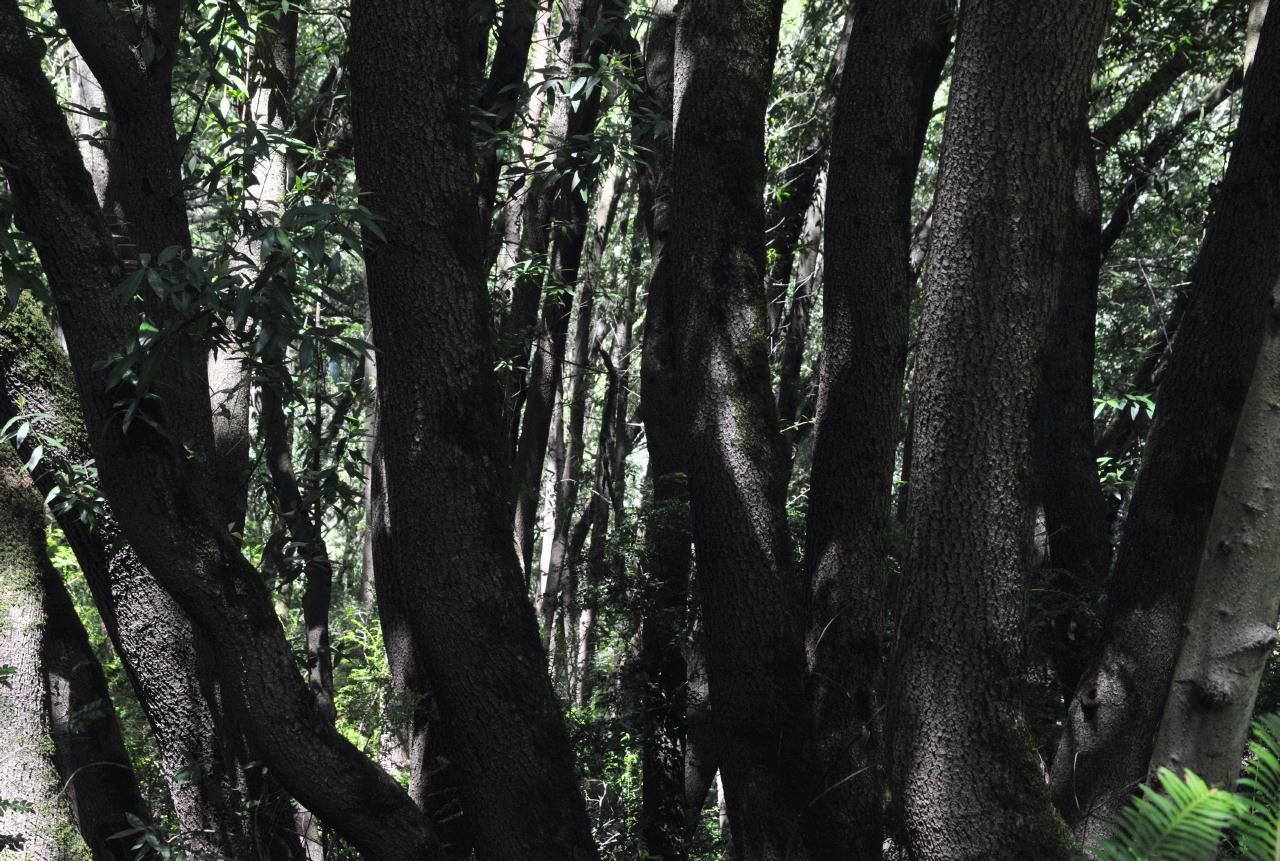 Downhill from the trail grew a dense forest that threw stripes of shade across the path.
Huckleberry Botanic Regional Preserve • East Bay Regional Parks District • Skyline Boulevard, Oakland, California • (Photo posted Tuesday 9 November 2010) • (Photo taken 13:43:10 Saturday 12 June 2010) • © 2010 Bryan Costales 
 #134310_6174BCX #134310_6174BCX
Add a comment or report a mistake
|
|
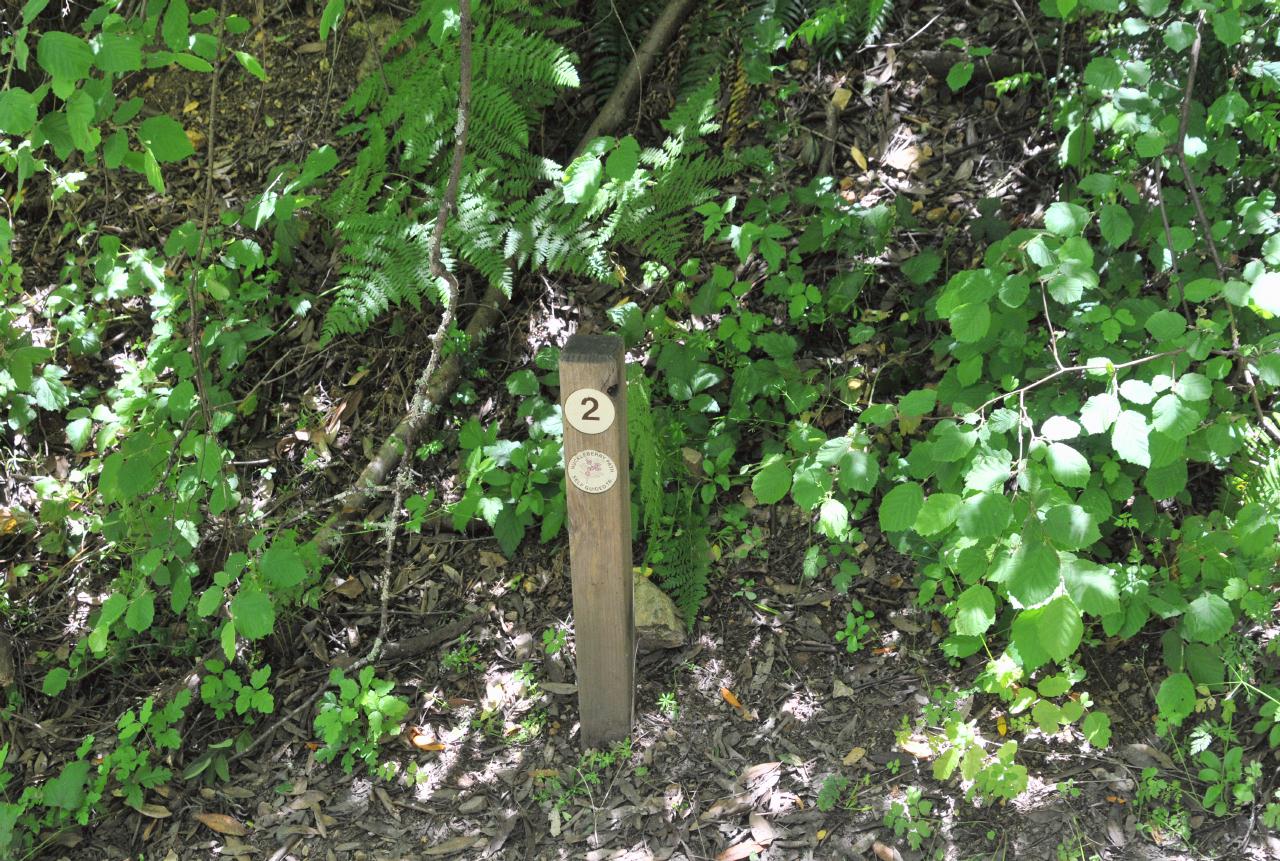 The numbers on posts along side the trail indicated numbered items inside the "Huckleberry Self-Guided Nature Path" pamphlet. This number, for example, described the, "California Hazelnut," a tree which grew just behind the sign.
Huckleberry Botanic Regional Preserve • East Bay Regional Parks District • Skyline Boulevard, Oakland, California • (Photo posted Tuesday 9 November 2010) • (Photo taken 13:48:32 Saturday 12 June 2010) • © 2010 Bryan Costales 
 #134832_6179BCX #134832_6179BCX
Add a comment or report a mistake
|
|
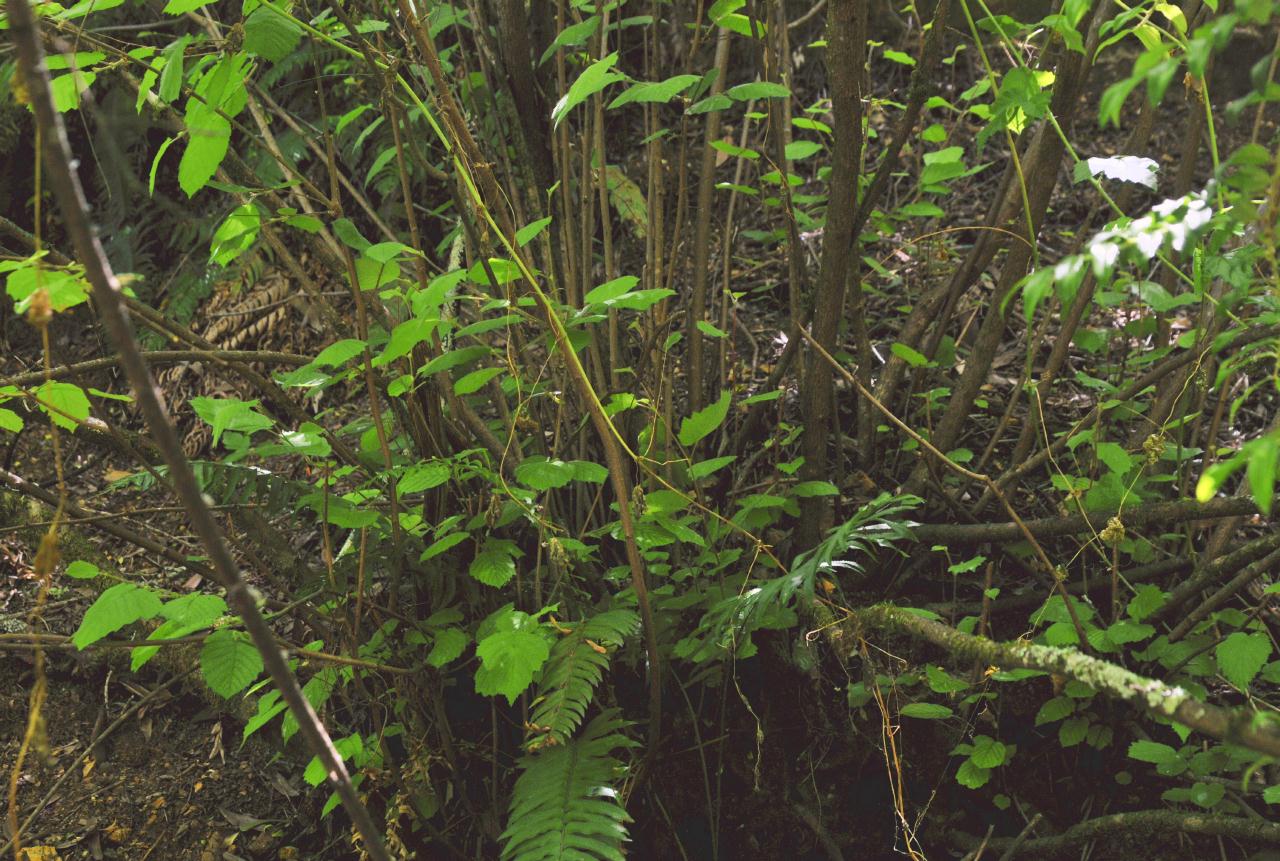
The California Hazelnut
Self-Guided Trail #2 • Huckleberry Botanic Regional Preserve • East Bay Regional Parks District • Skyline Boulevard, Oakland, California • (Photo posted Tuesday 9 November 2010) • (Photo taken 13:48:32 Saturday 12 June 2010) • © 2010 Bryan Costales 
 #134850_6108BCX #134850_6108BCX
Add a comment or report a mistake
|
|
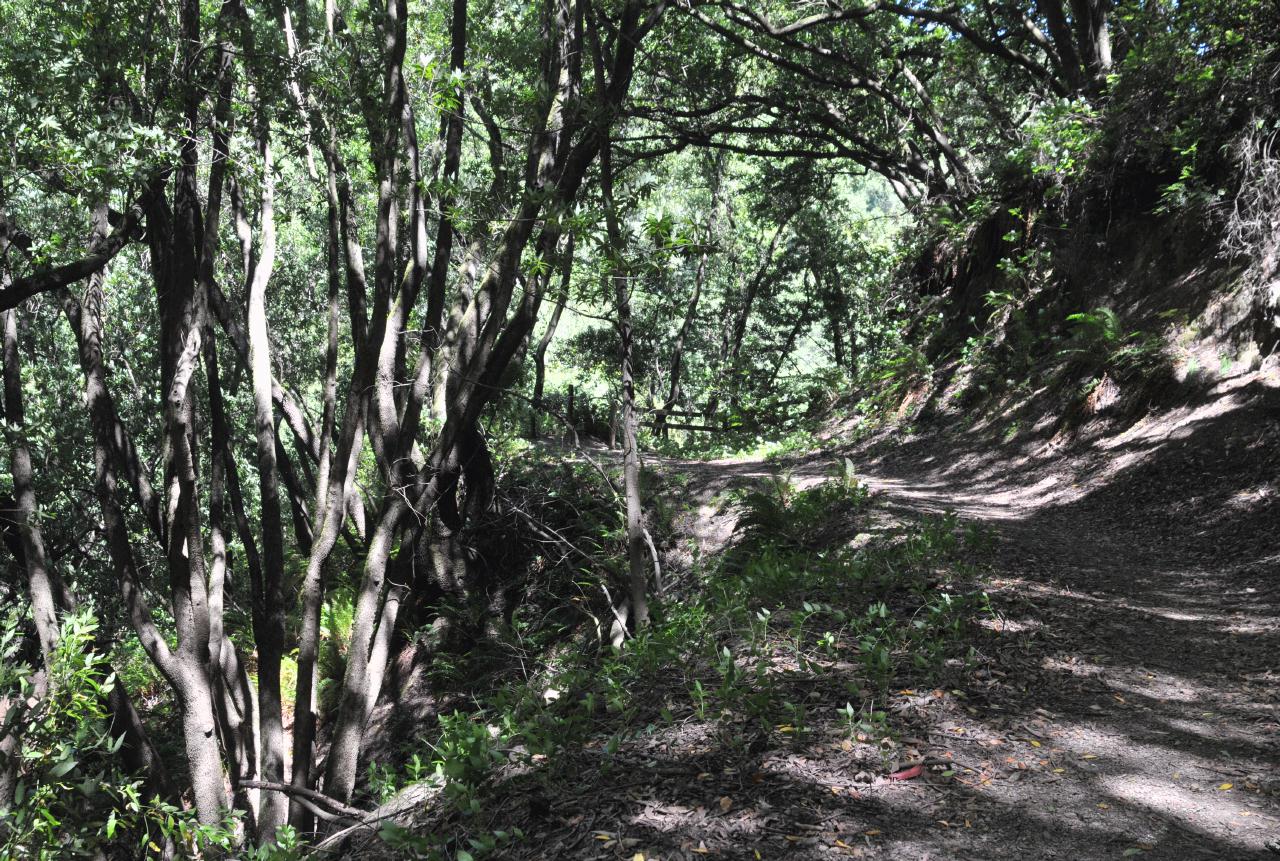 The trail continued and became shadow splattered from the surrounding forest. Notice the mature California Hazelnut just to the left of the trail.
Huckleberry Botanic Regional Preserve • East Bay Regional Parks District • Skyline Boulevard, Oakland, California • (Photo posted Tuesday 9 November 2010) • (Photo taken 13:55:38 Saturday 12 June 2010) • © 2010 Bryan Costales 
 #135538_6190BCX #135538_6190BCX
Add a comment or report a mistake
|
|
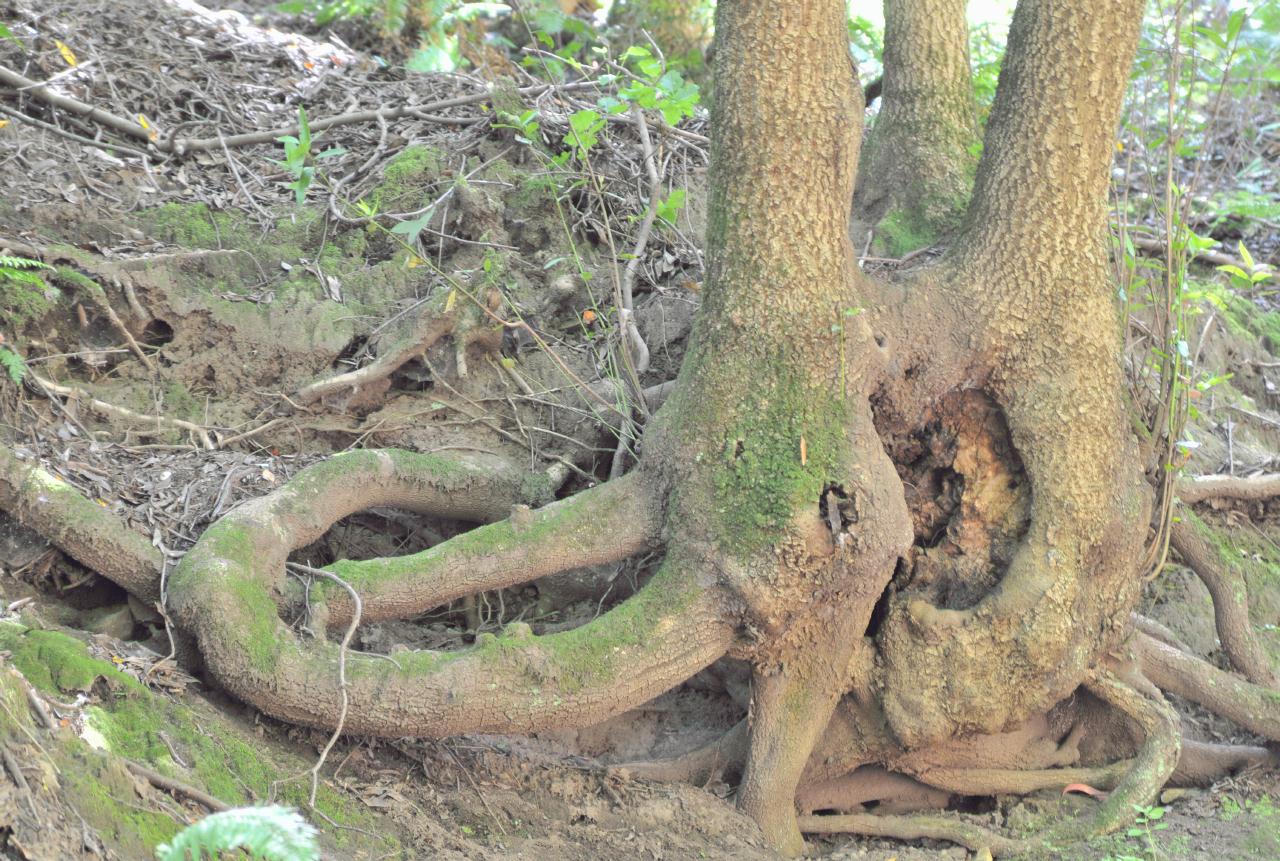 A fascinating assortment of twisted limbs and burls were found here and there along the trail. Here, one root ran underneath another.
Huckleberry Botanic Regional Preserve • East Bay Regional Parks District • Skyline Boulevard, Oakland, California • (Photo posted Tuesday 9 November 2010) • (Photo taken 13:56:52 Saturday 12 June 2010) • © 2010 Bryan Costales 
 #135652_6191BCX #135652_6191BCX
Add a comment or report a mistake
|
|
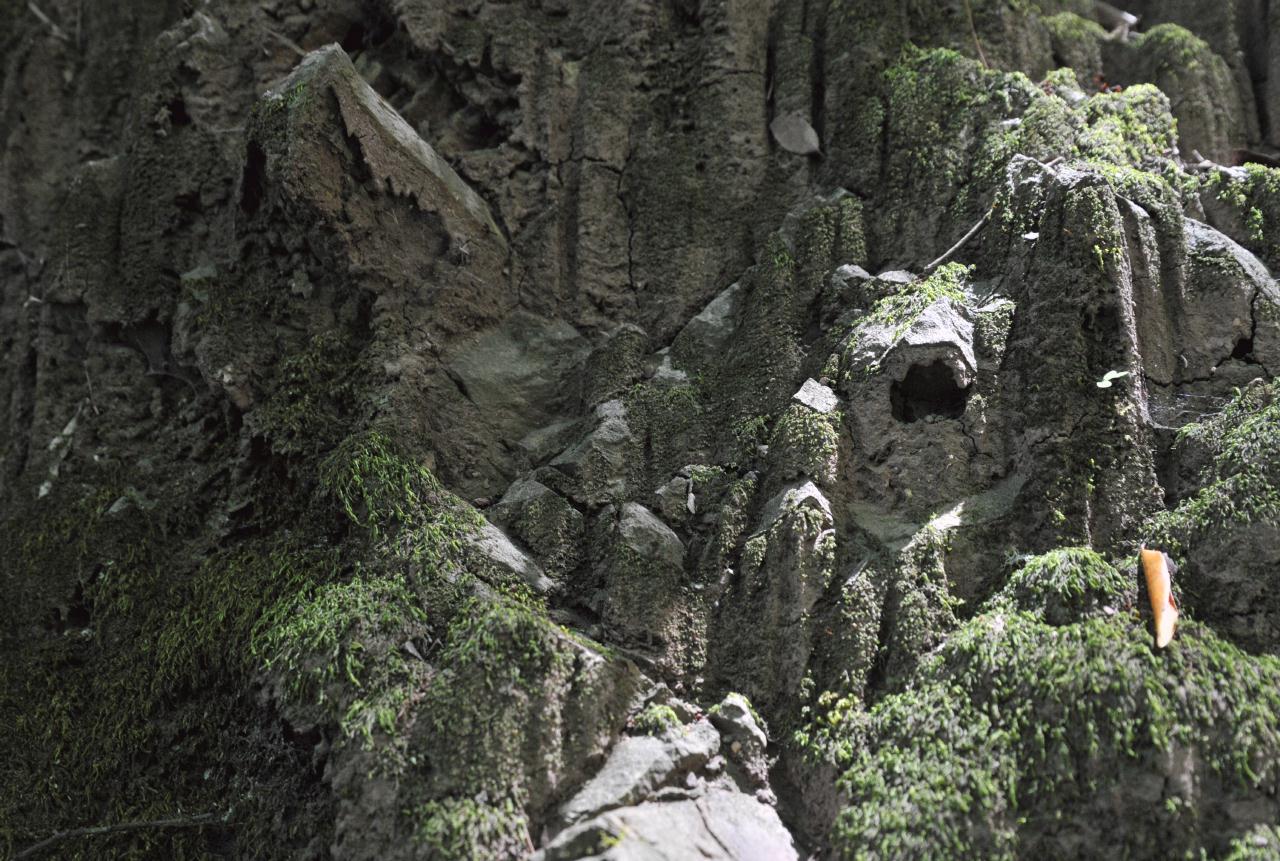 The trail wrapped around an eroded cliff face with details that could suggest animal forms to the imaginative.
Huckleberry Botanic Regional Preserve • East Bay Regional Parks District • Skyline Boulevard, Oakland, California • (Photo posted Tuesday 9 November 2010) • (Photo taken 13:57:18 Saturday 12 June 2010) • © 2010 Bryan Costales 
 #135718_6193BCX #135718_6193BCX
Add a comment or report a mistake
|
|
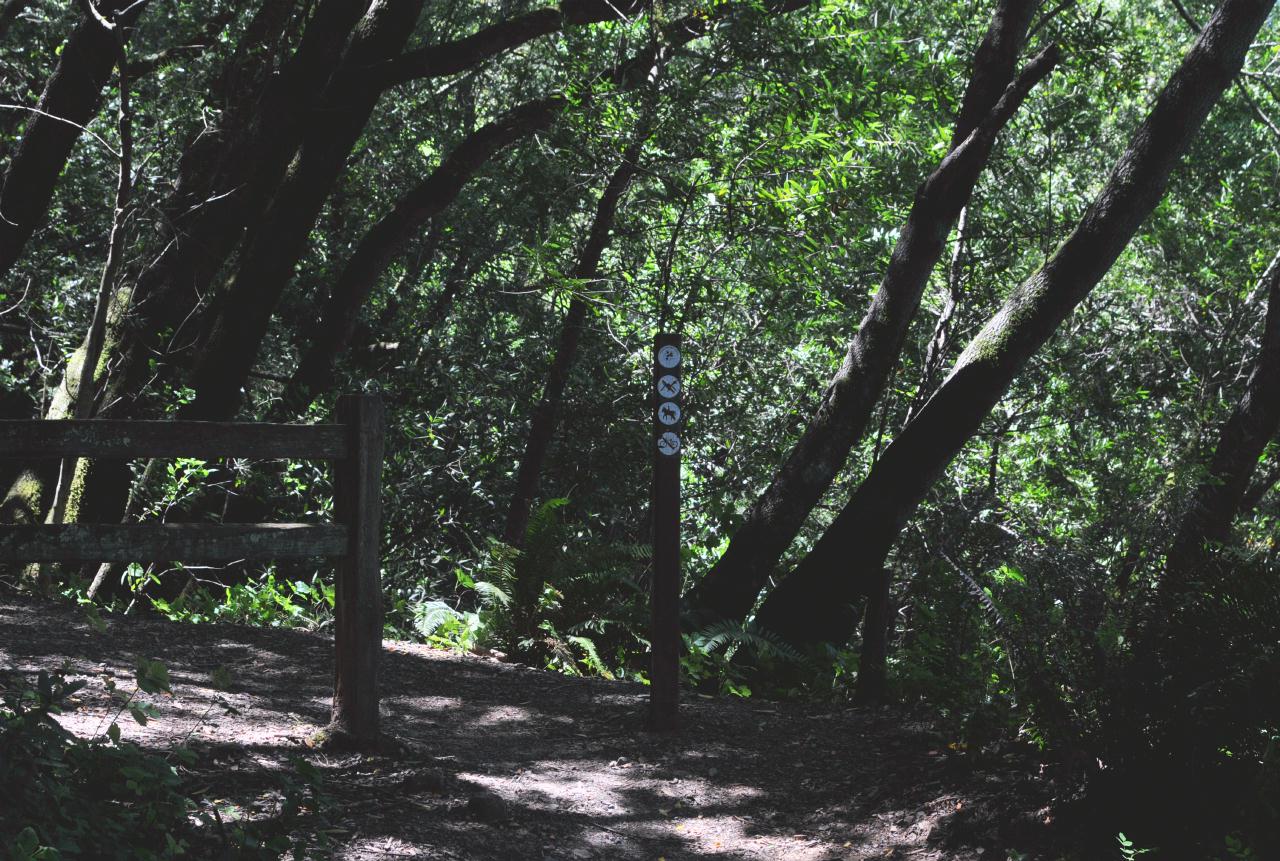 Here was where Huckleberry Self-Guided Path joined briefly with Skyline Trail. Because horses were permitted on Skyline Trail, equestrians were possible on the next section of path, but none were seen that day.
Huckleberry Botanic Regional Preserve • East Bay Regional Parks District • Skyline Boulevard, Oakland, California • (Photo posted Tuesday 9 November 2010) • (Photo taken 13:59:50 Saturday 12 June 2010) • © 2010 Bryan Costales 
 #135950_6198BCX #135950_6198BCX
Add a comment or report a mistake
|
|
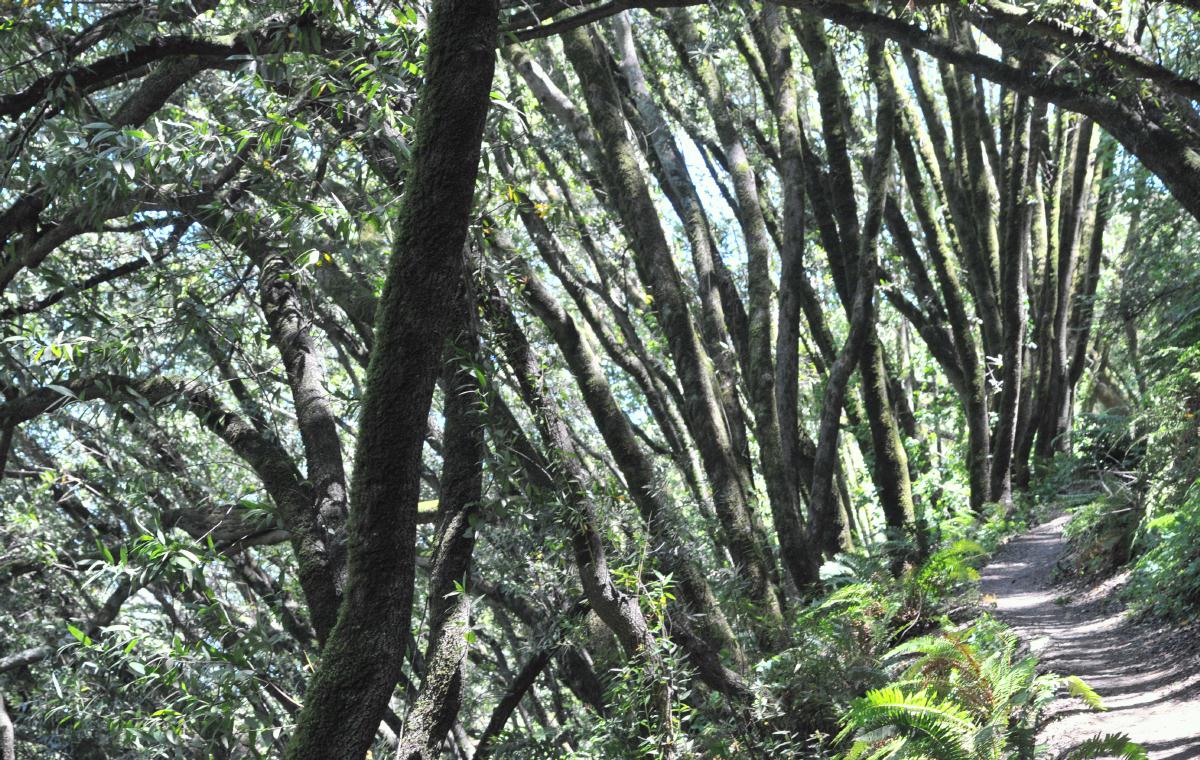 The self-guided path continued past a run of fanned out tree trunks. Although a bit disorienting in this shot, the path appeared perfectly normal in person.
Huckleberry Botanic Regional Preserve • East Bay Regional Parks District • Skyline Boulevard, Oakland, California • (Photo posted Tuesday 9 November 2010) • (Photo taken 14:01:00 Saturday 12 June 2010) • © 2010 Bryan Costales 
 #140100_6200BCX #140100_6200BCX
Add a comment or report a mistake
|
|
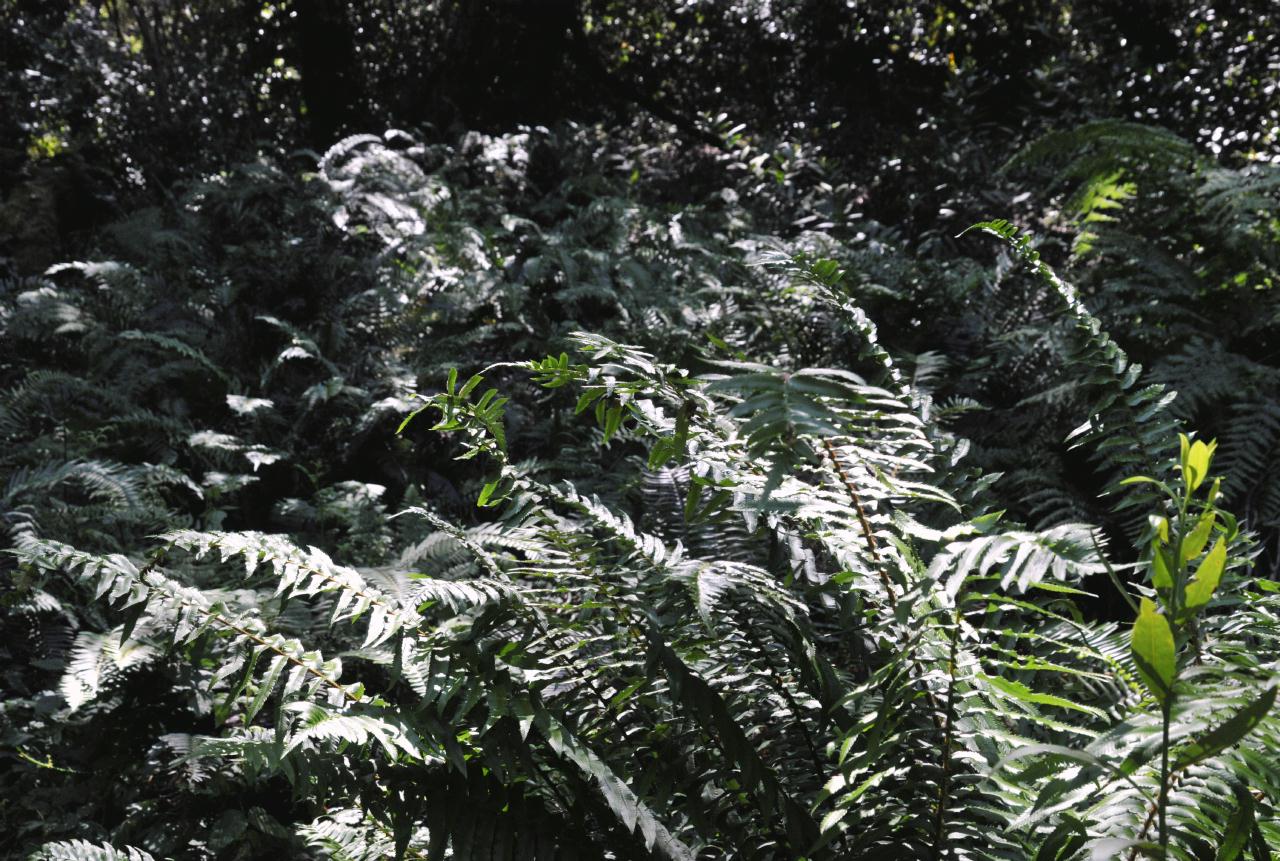
Western Sword Fern
Self Guided Trail post #3 • Huckleberry Botanic Regional Preserve • East Bay Regional Parks District • Skyline Boulevard, Oakland, California • (Photo posted Tuesday 9 November 2010) • (Photo taken 14:06:30 Saturday 12 June 2010) • © 2010 Bryan Costales 
 #140630_6202BCX #140630_6202BCX
Add a comment or report a mistake
|
|
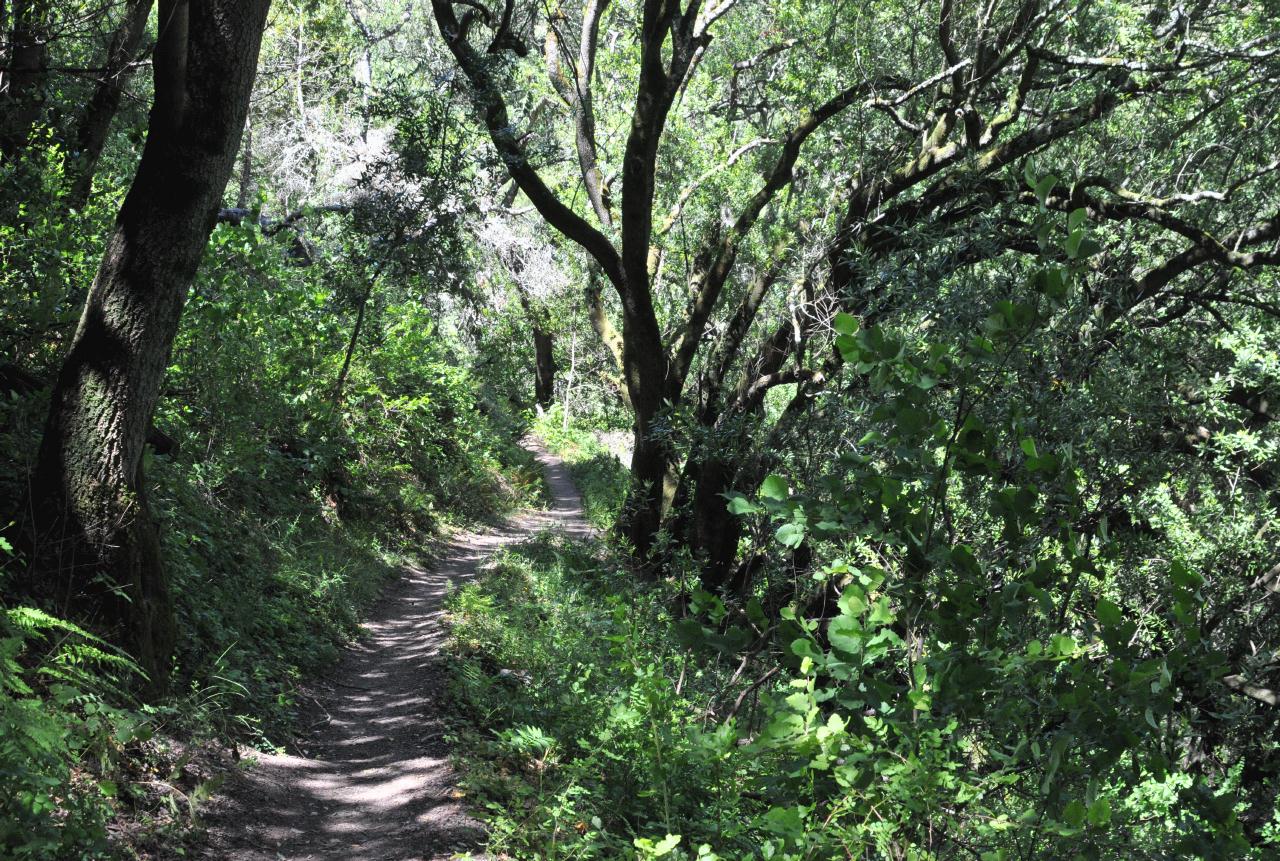 Following the Western Sword Fern, the trail took on the appearance of a faerie tale path.
Huckleberry Botanic Regional Preserve • East Bay Regional Parks District • Skyline Boulevard, Oakland, California • (Photo posted Tuesday 9 November 2010) • (Photo taken 14:14:06 Saturday 12 June 2010) • © 2010 Bryan Costales 
 #141406_6217BCX #141406_6217BCX
Add a comment or report a mistake
|
|
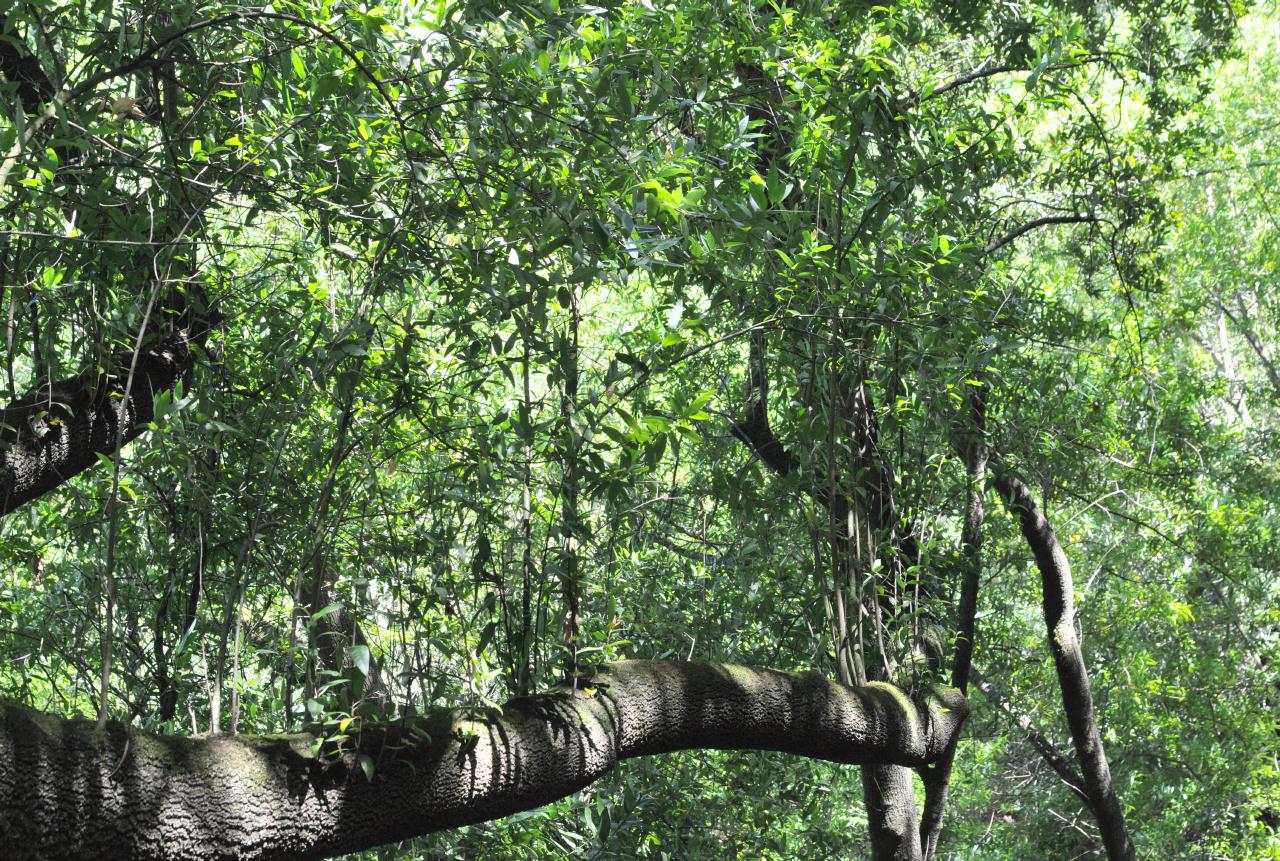 A miniature forest sprouted from the top of a long horizontal tree trunk.
Huckleberry Botanic Regional Preserve • East Bay Regional Parks District • Skyline Boulevard, Oakland, California • (Photo posted Tuesday 9 November 2010) • (Photo taken 14:14:54 Saturday 12 June 2010) • © 2010 Bryan Costales 
 #141454_6218BCX #141454_6218BCX
Add a comment or report a mistake
|
|
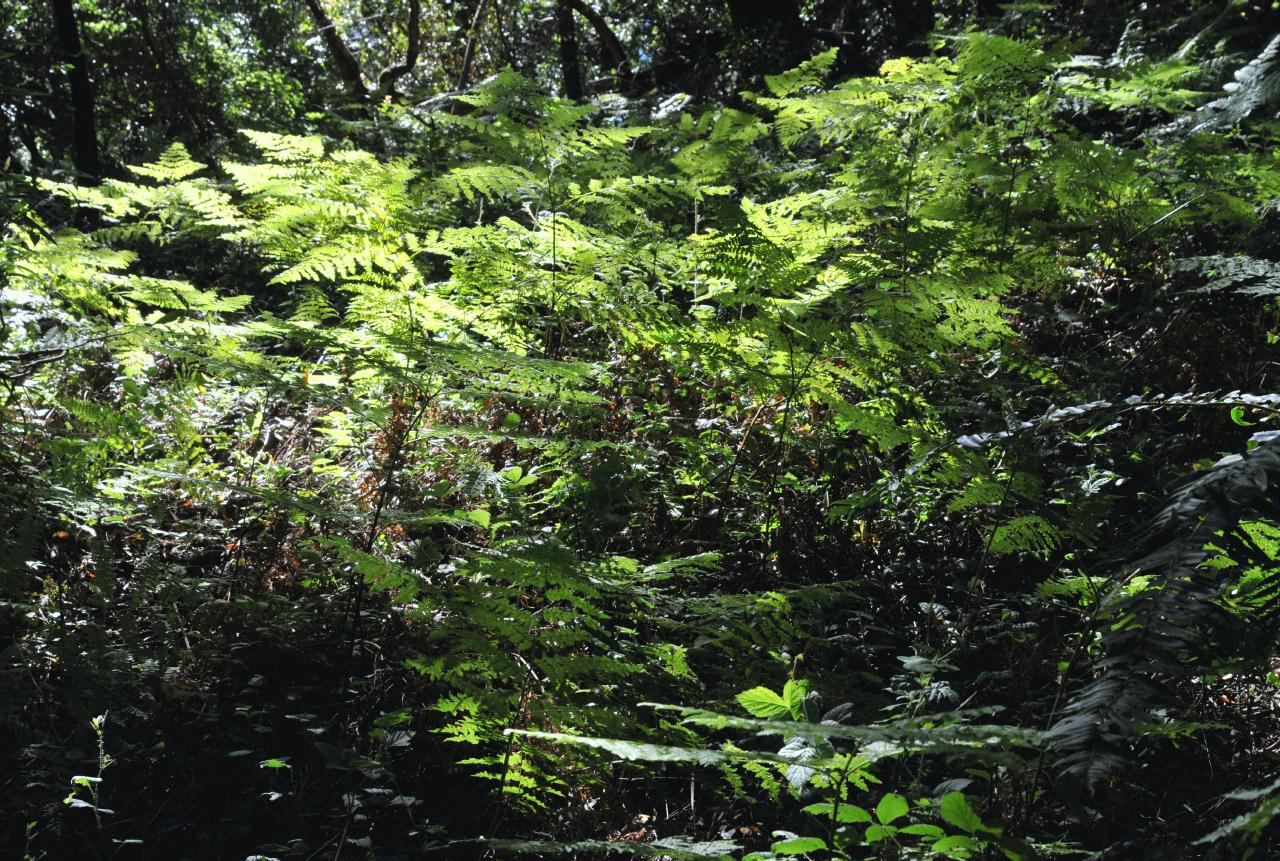
Wood Fern
Self-Guided Trail post #4 • Huckleberry Botanic Regional Preserve • East Bay Regional Parks District • Skyline Boulevard, Oakland, California • (Photo posted Tuesday 9 November 2010) • (Photo taken 14:19:40 Saturday 12 June 2010) • © 2010 Bryan Costales 
 #141940_6220BCX #141940_6220BCX
Add a comment or report a mistake
|
|
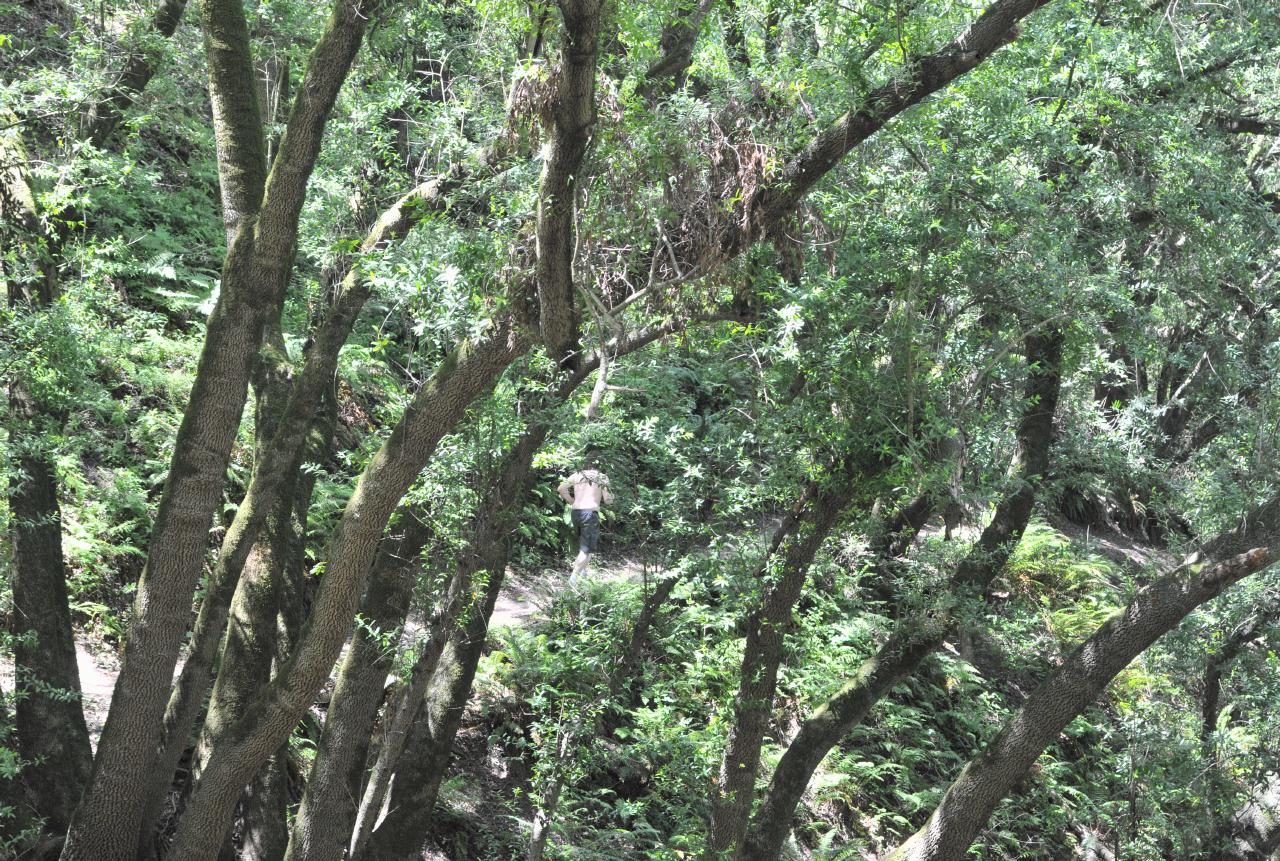 A jogger passed us heading back up the trail toward the parking lot. But because we were still on the shared path with Skyline Trail, it was also possible he was jogging on that longer trail.
Huckleberry Botanic Regional Preserve • East Bay Regional Parks District • Skyline Boulevard, Oakland, California • (Photo posted Tuesday 9 November 2010) • (Photo taken 14:22:08 Saturday 12 June 2010) • © 2010 Bryan Costales 
 #142208_6230BCX #142208_6230BCX
Add a comment or report a mistake
|
|
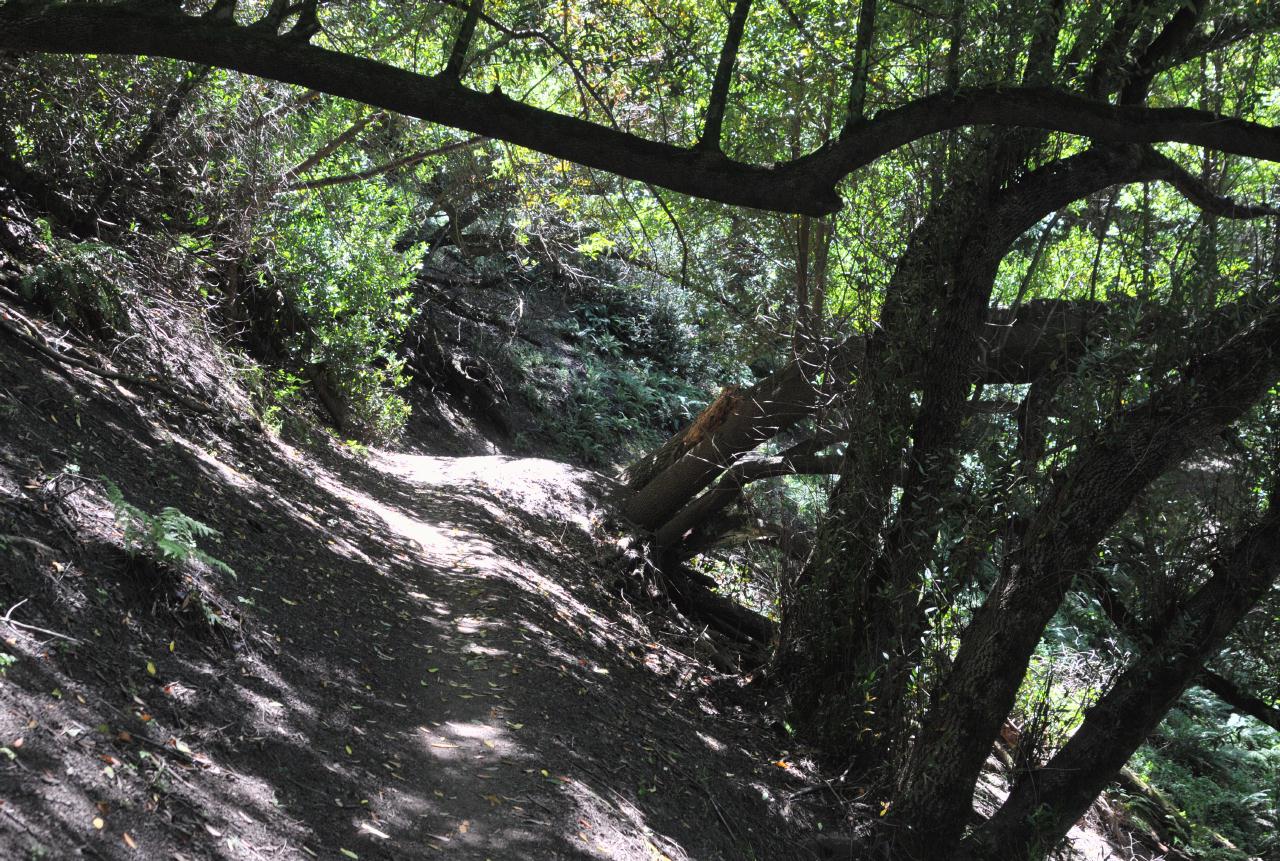 Continuing down, the trail narrowed and began a series of switch-back steps down a dramatic drop into a valley.
Huckleberry Botanic Regional Preserve • East Bay Regional Parks District • Skyline Boulevard, Oakland, California • (Photo posted Tuesday 9 November 2010) • (Photo taken 14:23:16 Saturday 12 June 2010) • © 2010 Bryan Costales 
 #142316_6232BCX #142316_6232BCX
Add a comment or report a mistake
|
|
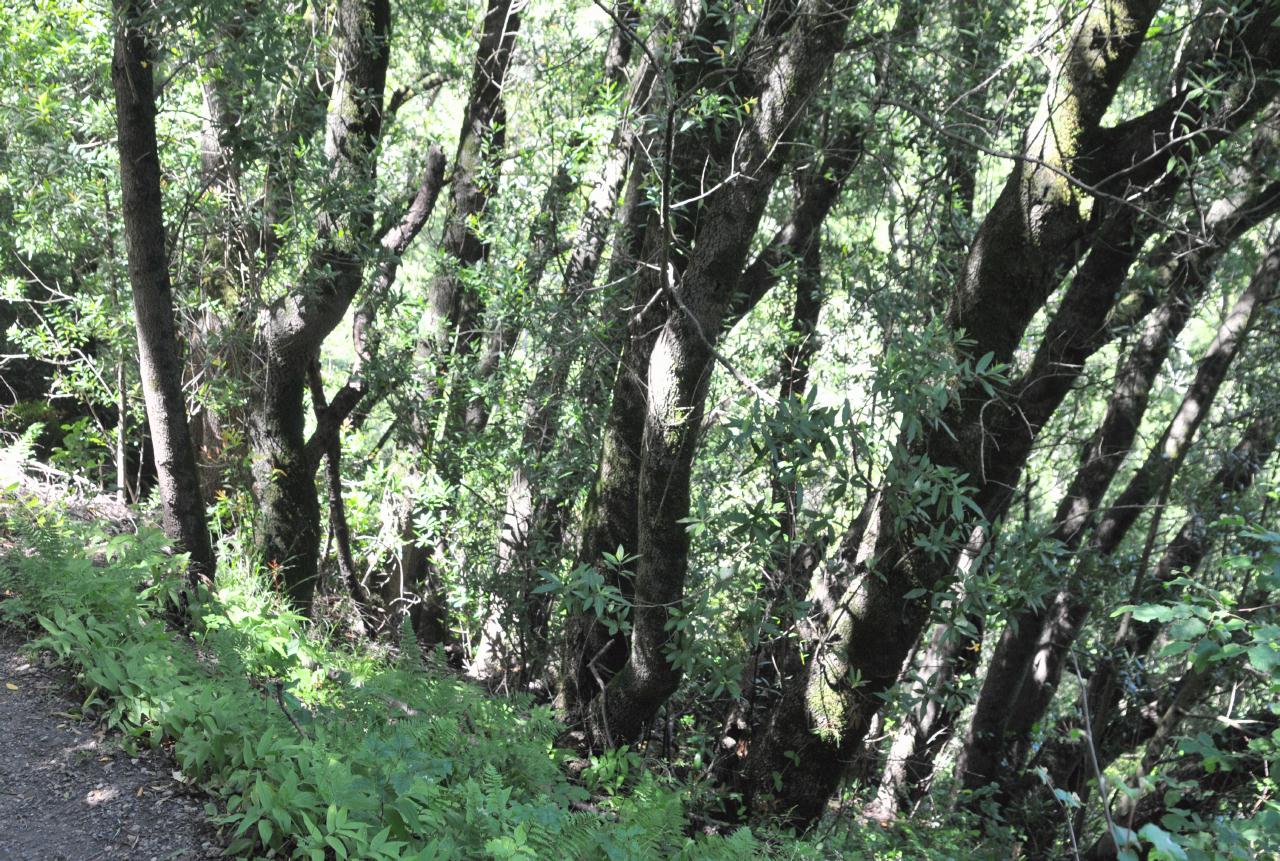
The
Bay Laurel
Self-Guided Tour post #5 • Huckleberry Botanic Regional Preserve • East Bay Regional Parks District • Skyline Boulevard, Oakland, California • (Photo posted Tuesday 9 November 2010) • (Photo taken 14:23:16 Saturday 12 June 2010) • © 2010 Bryan Costales 
 #143344_6254BCX #143344_6254BCX
Add a comment or report a mistake
|
|
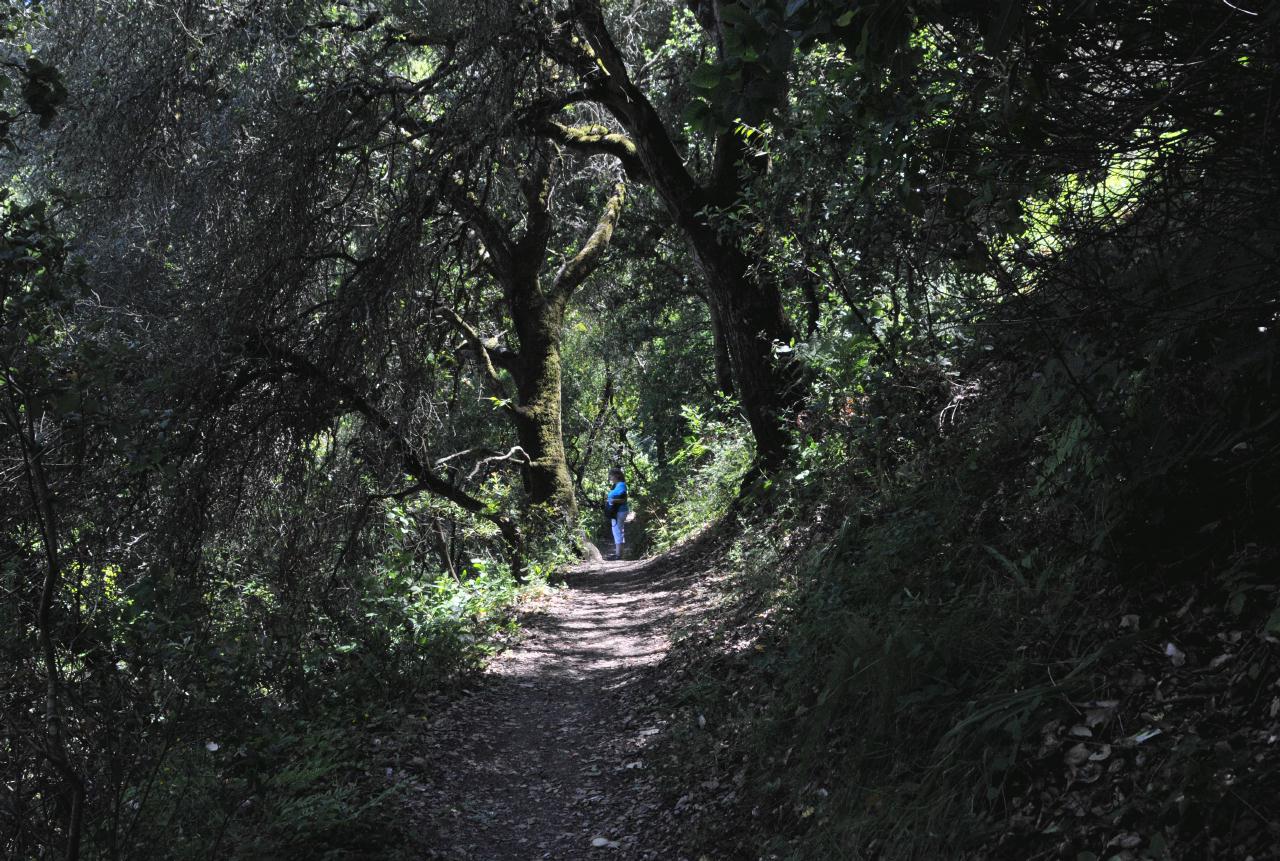 The valley was deeply shaded by huge mature trees.
Huckleberry Botanic Regional Preserve • East Bay Regional Parks District • Skyline Boulevard, Oakland, California • (Photo posted Tuesday 9 November 2010) • (Photo taken 14:34:46 Saturday 12 June 2010) • © 2010 Bryan Costales 
 #143446_6261BCX #143446_6261BCX
Add a comment or report a mistake
|
|
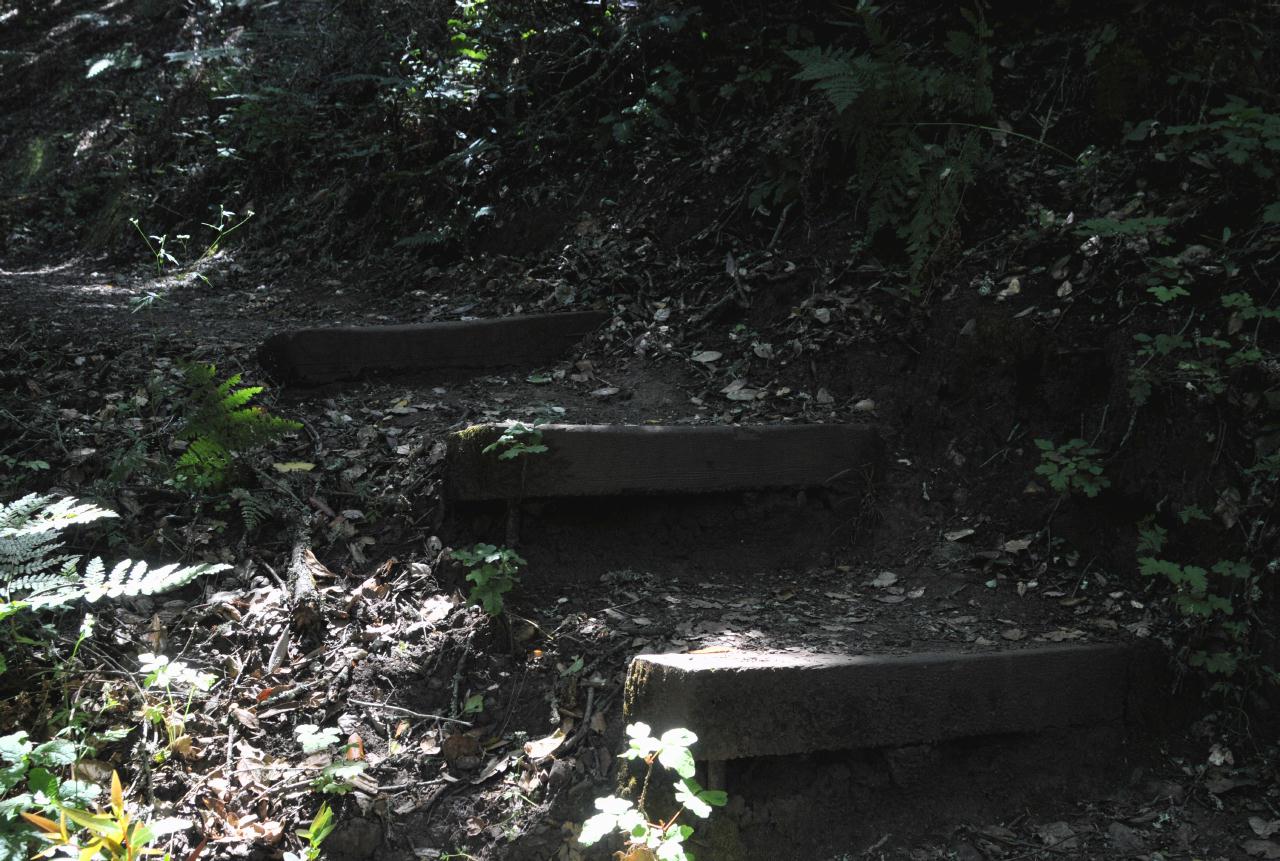 At the base of the valley, steps led up and out to continue the self-guided tour.
Huckleberry Botanic Regional Preserve • East Bay Regional Parks District • Skyline Boulevard, Oakland, California • (Photo posted Tuesday 9 November 2010) • (Photo taken 14:42:22 Saturday 12 June 2010) • © 2010 Bryan Costales 
 #144222_6268BCX #144222_6268BCX
Add a comment or report a mistake
|
|
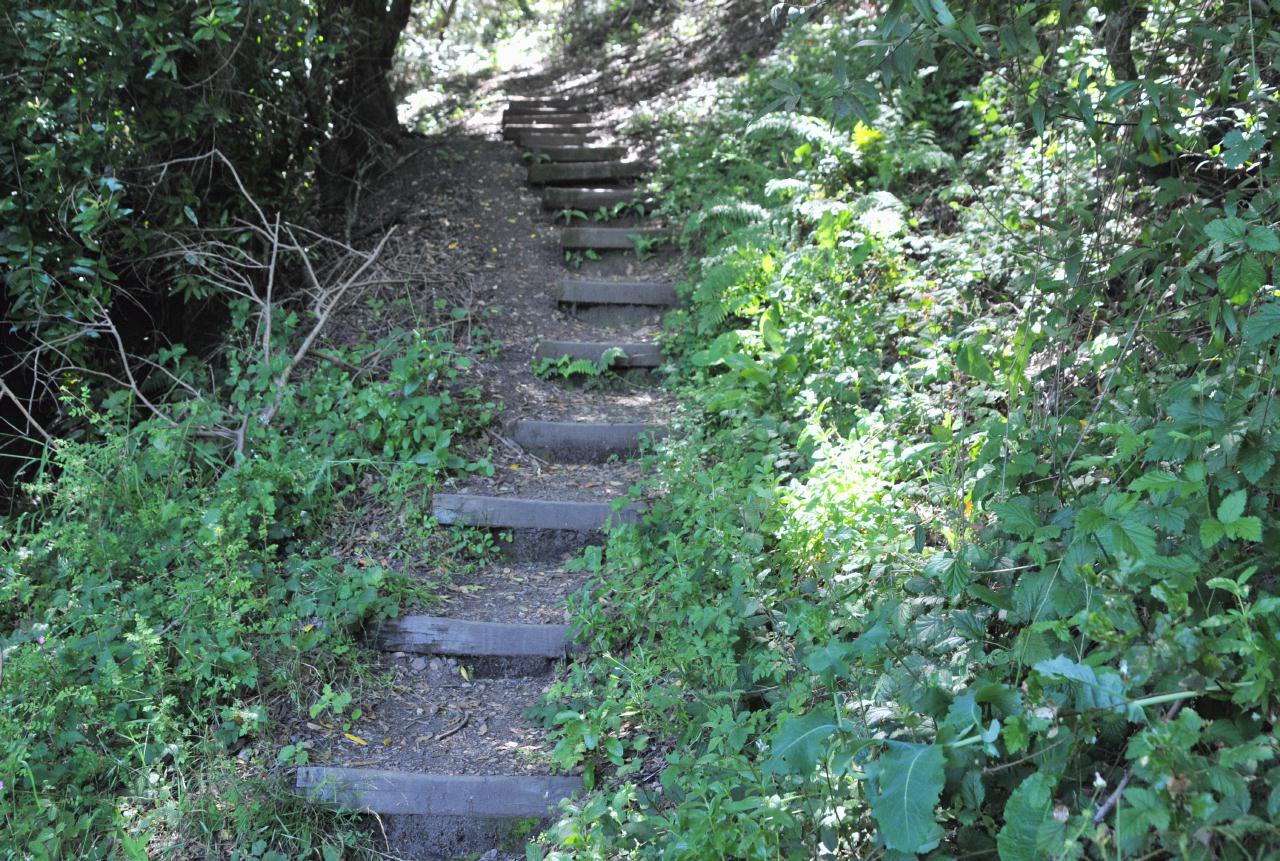 And it was not just a few steps that led up and out of the valley. Each was a retaining board, back filled with dirt to form a step.
Huckleberry Botanic Regional Preserve • East Bay Regional Parks District • Skyline Boulevard, Oakland, California • (Photo posted Tuesday 9 November 2010) • (Photo taken 14:44:26 Saturday 12 June 2010) • © 2010 Bryan Costales 
 #144426_6269BCX #144426_6269BCX
Add a comment or report a mistake
|
|
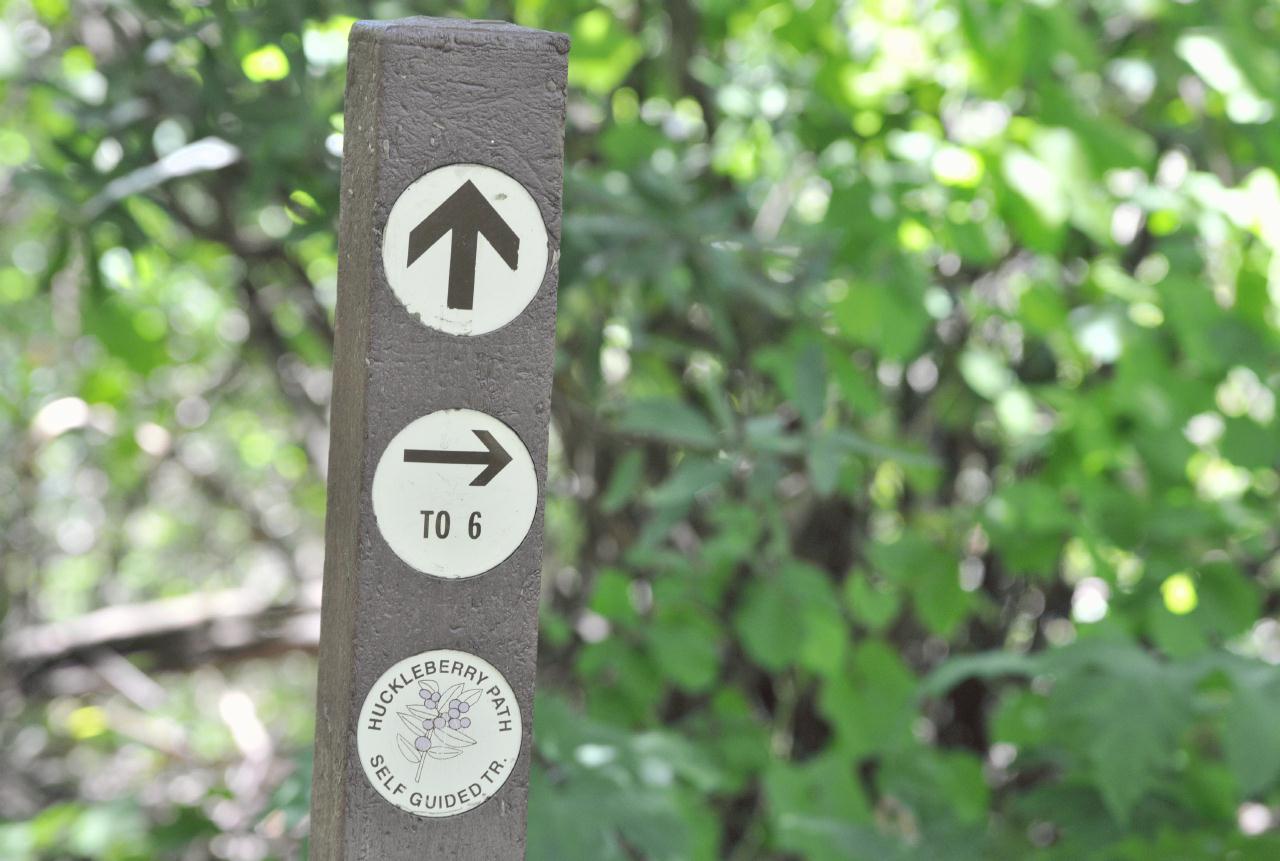 Just as the walker was beginning to tire at the top of the steps, a side trip was indicated that led to post #6.
Huckleberry Botanic Regional Preserve • East Bay Regional Parks District • Skyline Boulevard, Oakland, California • (Photo posted Tuesday 9 November 2010) • (Photo taken 14:51:36 Saturday 12 June 2010) • © 2010 Bryan Costales 
 #145136_6272BCX #145136_6272BCX
Add a comment or report a mistake
|
|
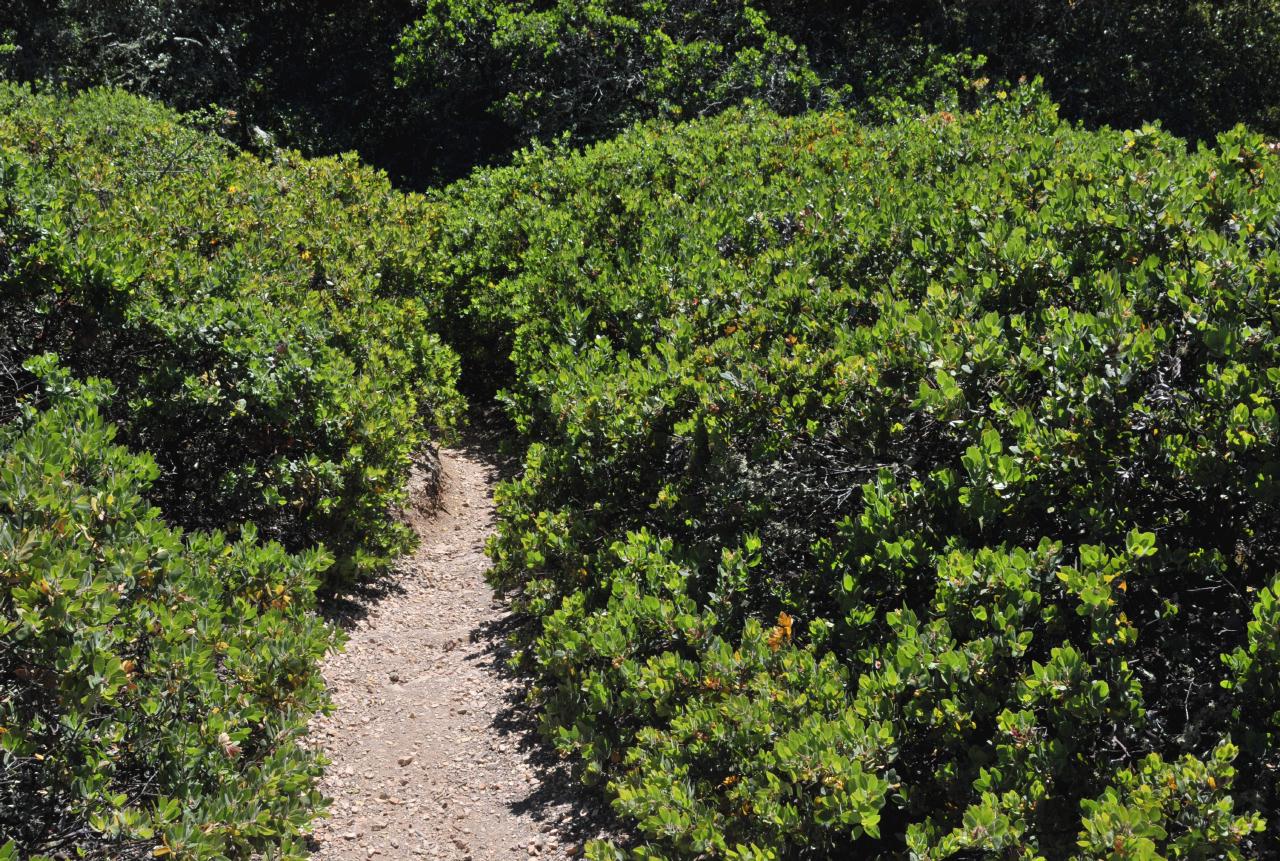
A Manzanita Barren
Self-Guided Tour post #6 • Huckleberry Botanic Regional Preserve • East Bay Regional Parks District • Skyline Boulevard, Oakland, California • (Photo posted Tuesday 9 November 2010) • (Photo taken 14:51:36 Saturday 12 June 2010) • © 2010 Bryan Costales 
 #145310_6274BCX #145310_6274BCX
Add a comment or report a mistake
|
|
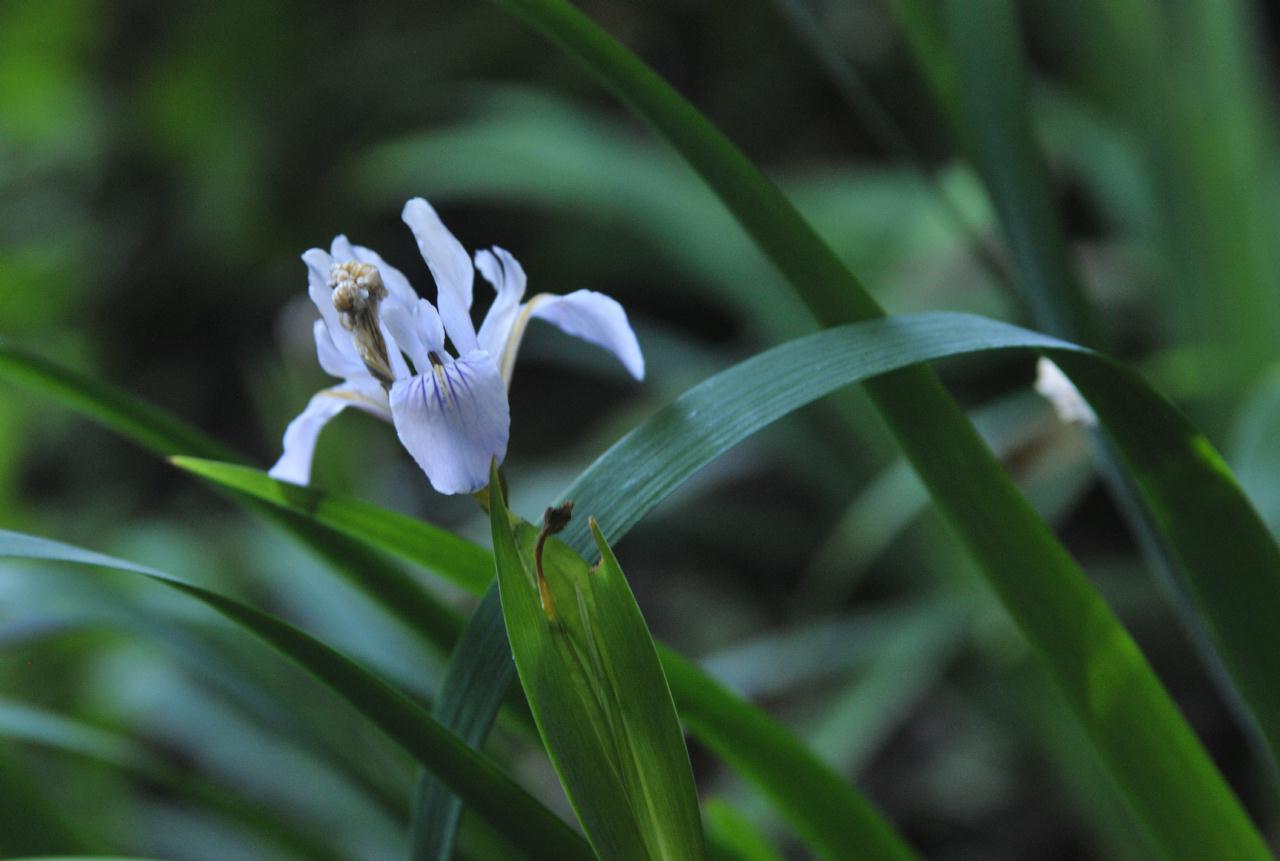
Douglas Iris
Self-Guided Tour post #7 • Huckleberry Botanic Regional Preserve • East Bay Regional Parks District • Skyline Boulevard, Oakland, California • (Photo posted Tuesday 9 November 2010) • (Photo taken 15:10:54 Saturday 12 June 2010) • © 2010 Bryan Costales 
 #151054_6306BCX #151054_6306BCX
Add a comment or report a mistake
|
|
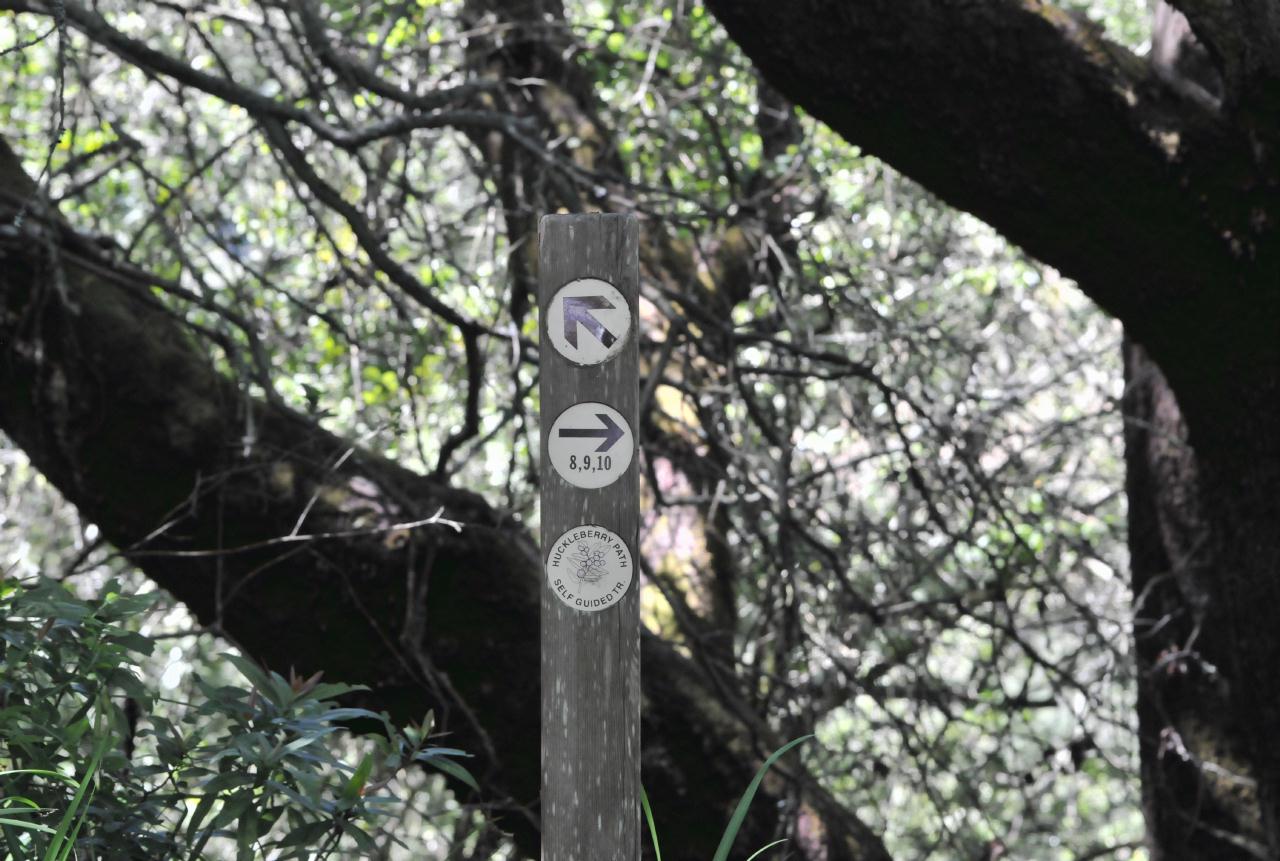 Back out of the first side trip, a second side trip appeared for yet another detour.
Huckleberry Botanic Regional Preserve • East Bay Regional Parks District • Skyline Boulevard, Oakland, California • (Photo posted Tuesday 9 November 2010) • (Photo taken 15:16:12 Saturday 12 June 2010) • © 2010 Bryan Costales 
 #151612_6316BCX #151612_6316BCX
Add a comment or report a mistake
|
|
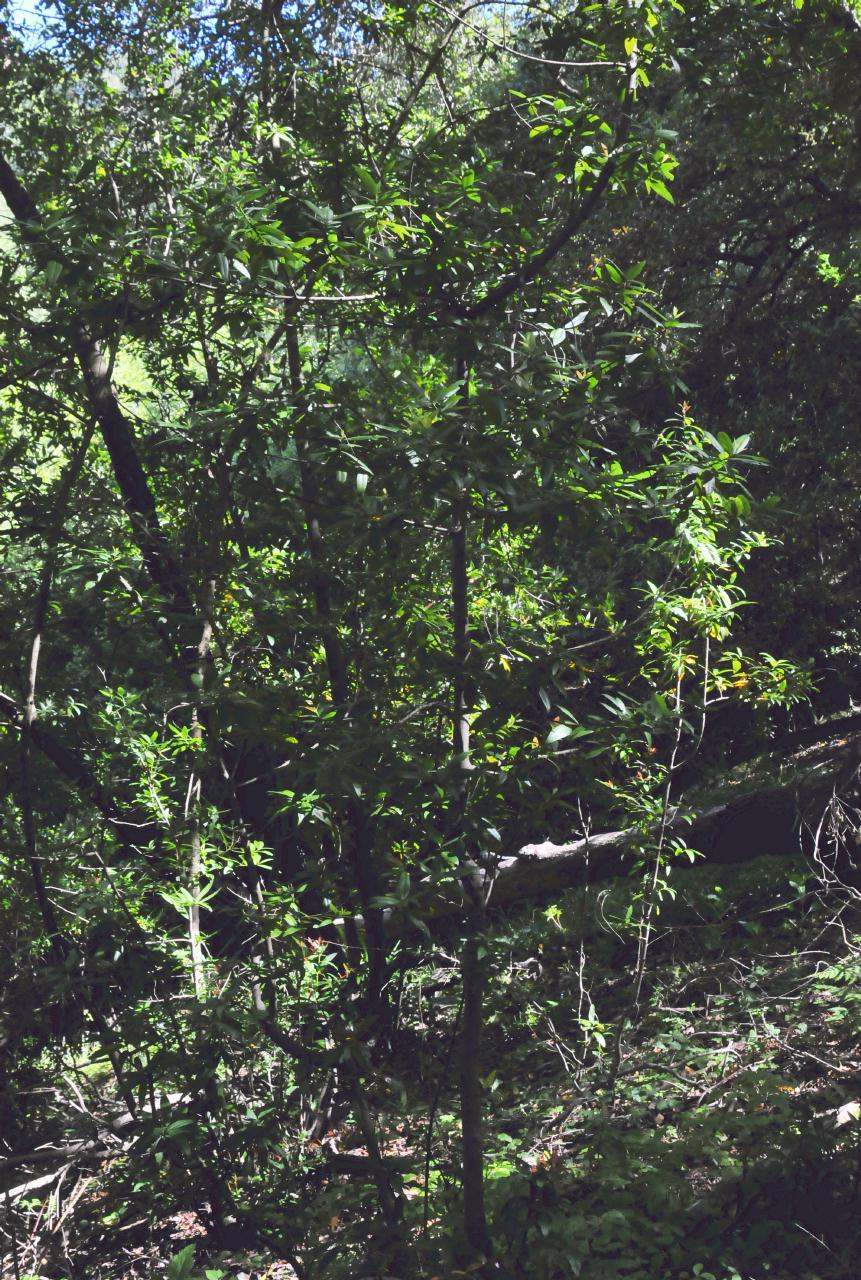 Western Leatherwood (Dirca occidentalis) From the pamphlet, "Flowers December to March. Deciduous. Just before leatherwood breaks dormancy, the intricate naked branchlets produce lemon-yellow blooms at tips. Due to a peculiar S-shaped arrangement of its wood fibers, leatherwood has very flexible, pliable branches, hence its common name. Extremely rare."
Self-Guided Tour post #8 • Huckleberry Botanic Regional Preserve • East Bay Regional Parks District • Skyline Boulevard, Oakland, California • (Photo posted Tuesday 9 November 2010) • (Photo taken 15:18:00 Saturday 12 June 2010) • © 2010 Bryan Costales 
 #151800_6318BCX #151800_6318BCX
Add a comment or report a mistake
|
|
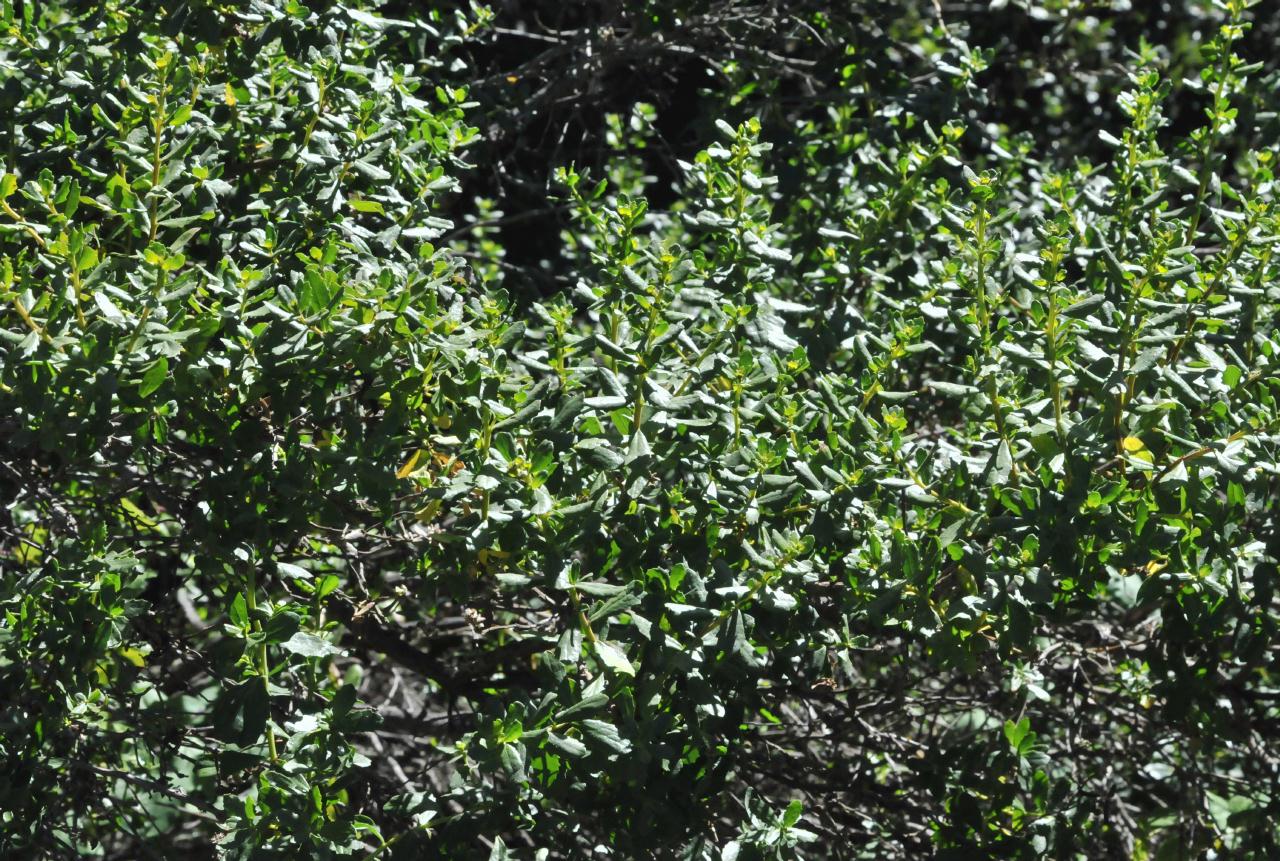 Jimbrush (Ceanothus sorediatus) From the pamphlet, "The thorny, rigid, twiggy growth produces soft blue blossoms in spring. Like most Caenothus, an ardent pioneer of disturbed or burned-over soils. The Indians made shampoo from the flowers of this species."
Self-Guided Tour post #9 • Huckleberry Botanic Regional Preserve • East Bay Regional Parks District • Skyline Boulevard, Oakland, California • (Photo posted Tuesday 9 November 2010) • (Photo taken 15:18:00 Saturday 12 June 2010) • © 2010 Bryan Costales 
 #152009_6322BCX #152009_6322BCX
Add a comment or report a mistake
|
|
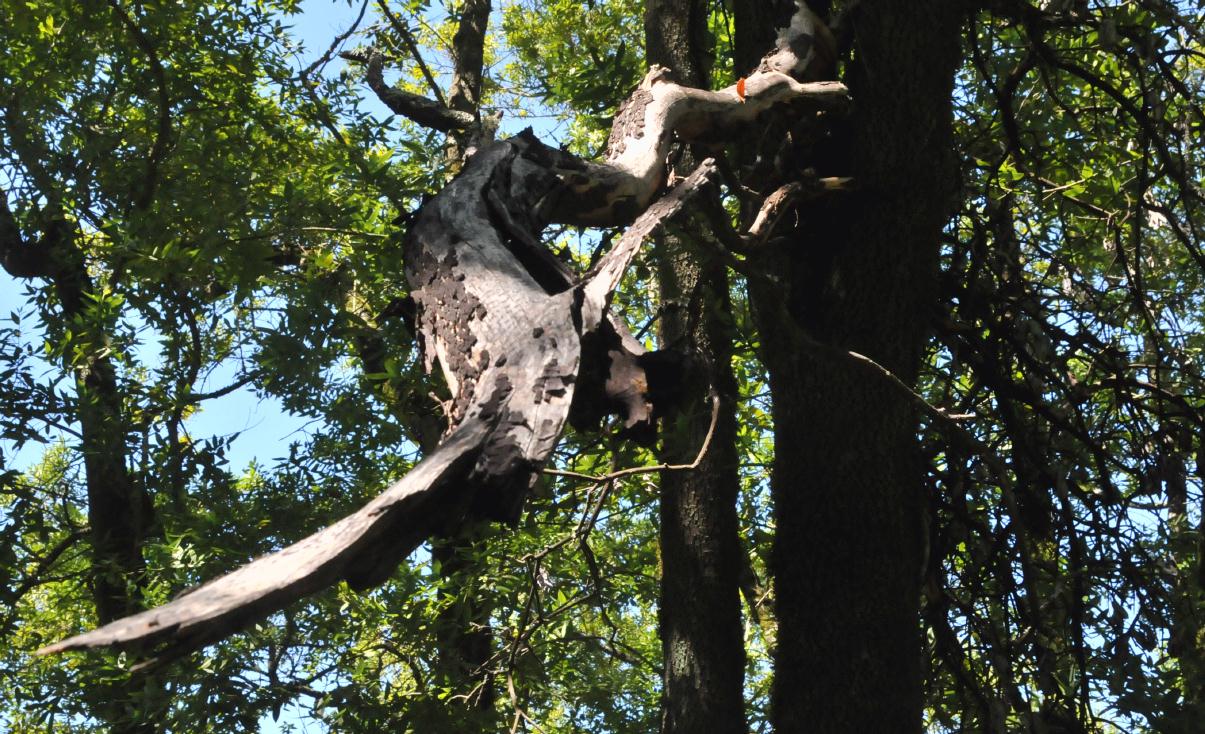 Canyon Live Oak (Quercus chrysoepis) From the pamphlet, "This oak can be identified by the sometimes grayish but usually golden fuzz on the leaf undersides. Stout acorns rest in the thickened, fuzzy, golden cups. Also has a basal burl."
Self-Guided Tour post #10 • Huckleberry Botanic Regional Preserve • East Bay Regional Parks District • Skyline Boulevard, Oakland, California • (Photo posted Tuesday 9 November 2010) • (Photo taken 15:23:46 Saturday 12 June 2010) • © 2010 Bryan Costales 
 #152346_6325BCX #152346_6325BCX
Add a comment or report a mistake
|
|
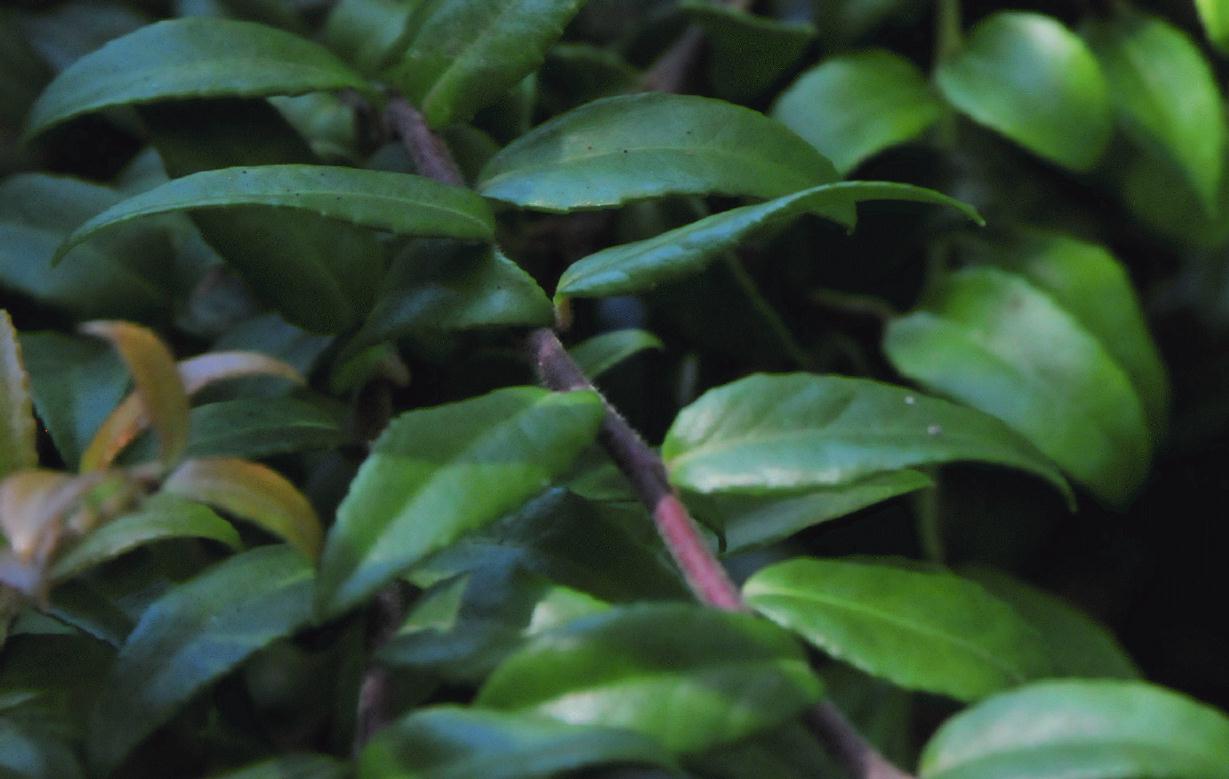
Coast Huckleberry
Self-Guided Tour post #11 • Huckleberry Botanic Regional Preserve • East Bay Regional Parks District • Skyline Boulevard, Oakland, California • (Photo posted Tuesday 9 November 2010) • (Photo taken 15:24:24 Saturday 12 June 2010) • © 2010 Bryan Costales 
 #152424_6327BCX #152424_6327BCX
Add a comment or report a mistake
|
|
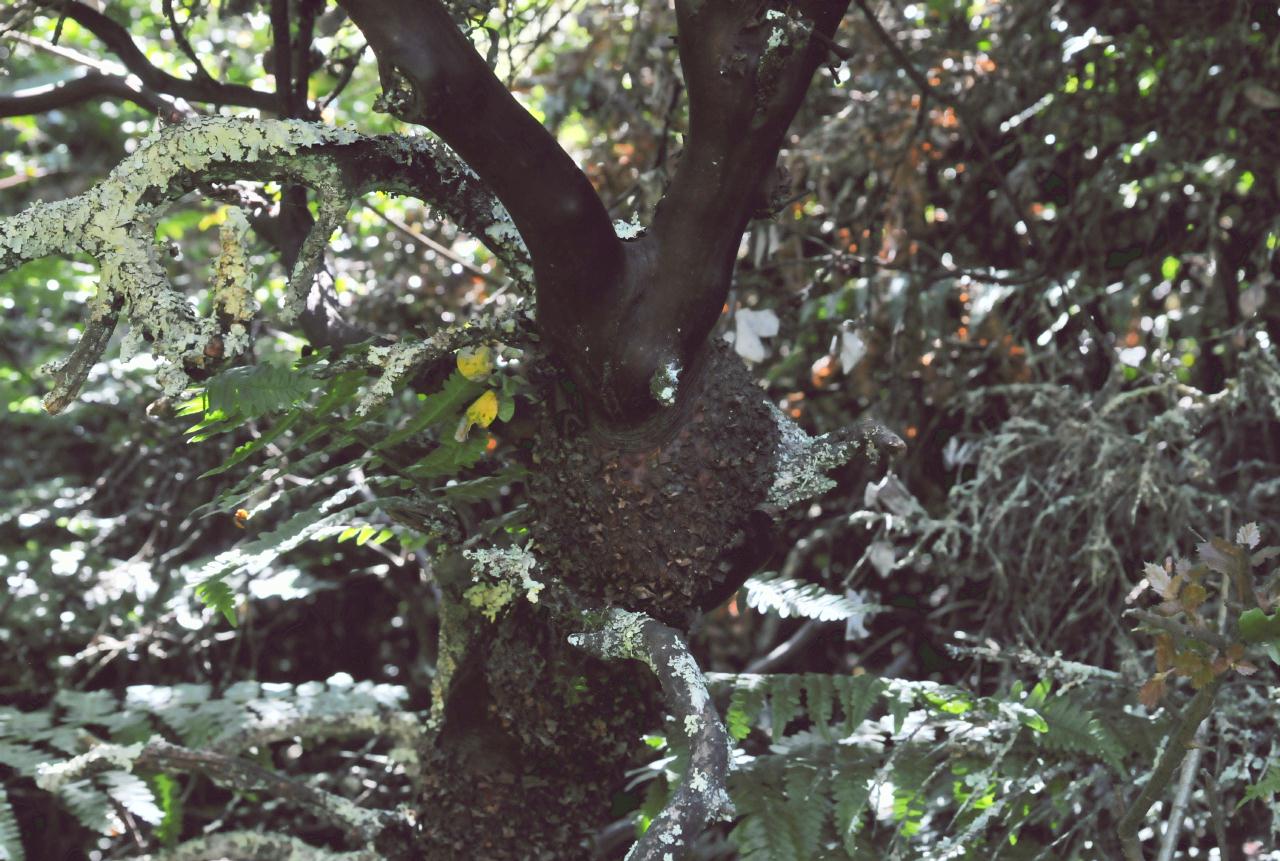 Alongside the main trail could be found the occasional manzanita. Here was one manzanita with a burl at the base of its trunk.
Huckleberry Botanic Regional Preserve • East Bay Regional Parks District • Skyline Boulevard, Oakland, California • (Photo posted Tuesday 9 November 2010) • (Photo taken 15:27:55 Saturday 12 June 2010) • © 2010 Bryan Costales 
 #152755_6337BCX #152755_6337BCX
Add a comment or report a mistake
|
|
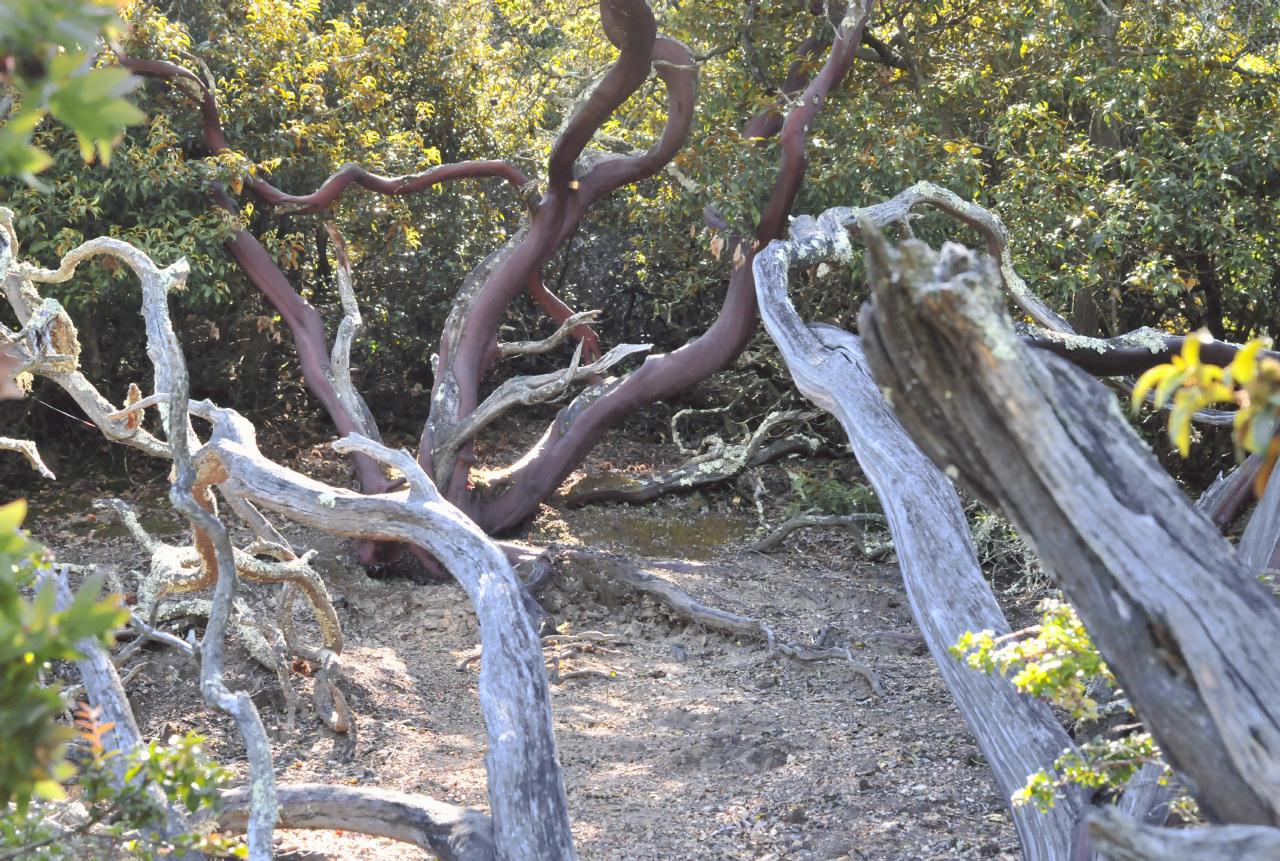 In one clearing, the randomly twisted arms of manzanita suggested a modern dance.
Huckleberry Botanic Regional Preserve • East Bay Regional Parks District • Skyline Boulevard, Oakland, California • (Photo posted Tuesday 9 November 2010) • (Photo taken 15:30:07 Saturday 12 June 2010) • © 2010 Bryan Costales 
 #153007_6344BCX #153007_6344BCX
Add a comment or report a mistake
|
|
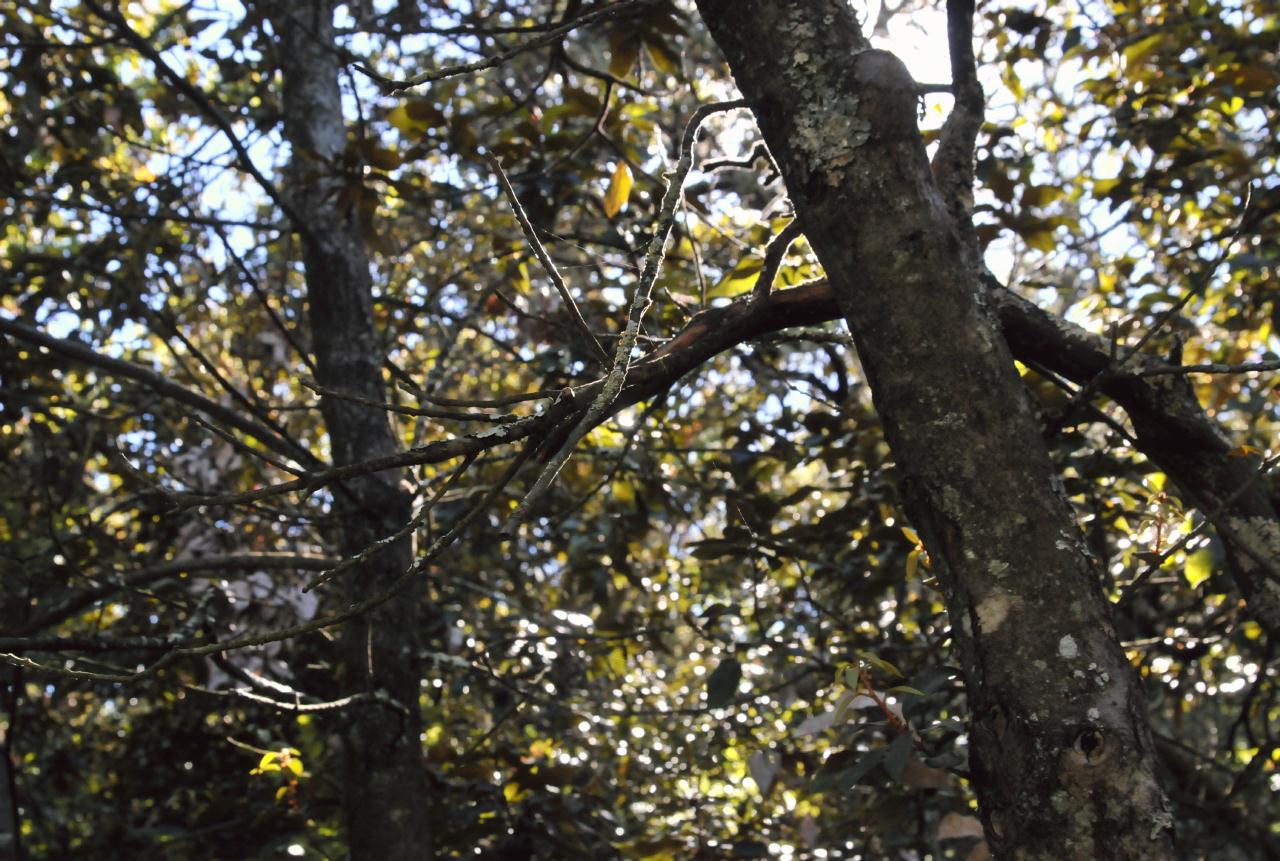 Chinquapin (Castanopsis chrysophylla var. minor) From the pamphlet, "The keeled (boat shaped), dark green leaves with a golden fuzz on the undersides, and the spiny, yellow, bur-like fruit encasing several hard nutlets, make the chinquapin hard to be mistaken. Fickers, jays and perhaps other birds readily extract the nutlets from the thorny burrs in fall and winter. Note the basal burl."
Self-Guided Trail post #13 • Huckleberry Botanic Regional Preserve • East Bay Regional Parks District • Skyline Boulevard, Oakland, California • (Photo posted Tuesday 9 November 2010) • (Photo taken 15:32:18 Saturday 12 June 2010) • © 2010 Bryan Costales 
 #153218_6349BCX #153218_6349BCX
Add a comment or report a mistake
|
|
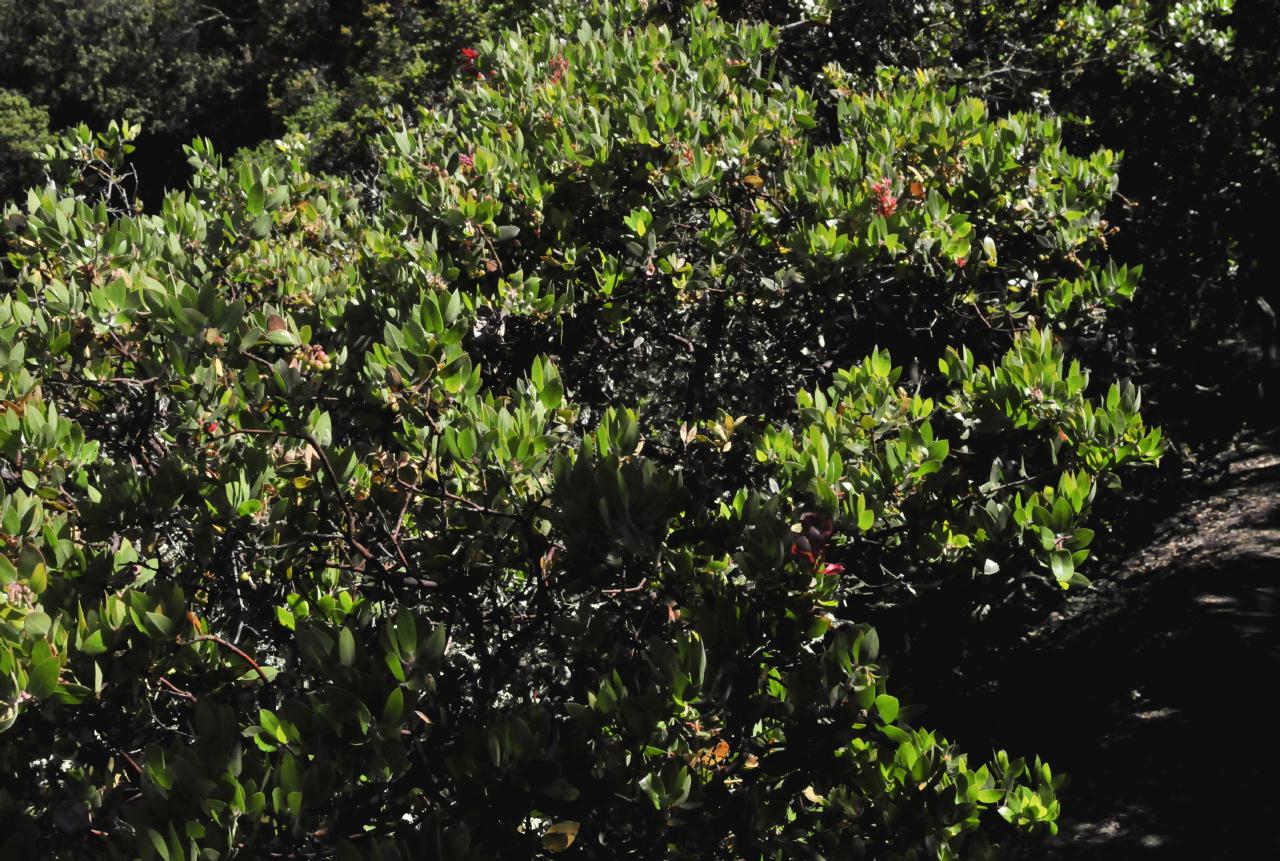
Brittleleaf Manzanita
Self-Guided Tour post #14 Huckleberry Botanic Regional Preserve • East Bay Regional Parks District • Skyline Boulevard, Oakland, California • (Photo posted Tuesday 9 November 2010) • (Photo taken 15:36:13 Saturday 12 June 2010) • © 2010 Bryan Costales 
 #153613_6369BCX #153613_6369BCX
Add a comment or report a mistake
|
|
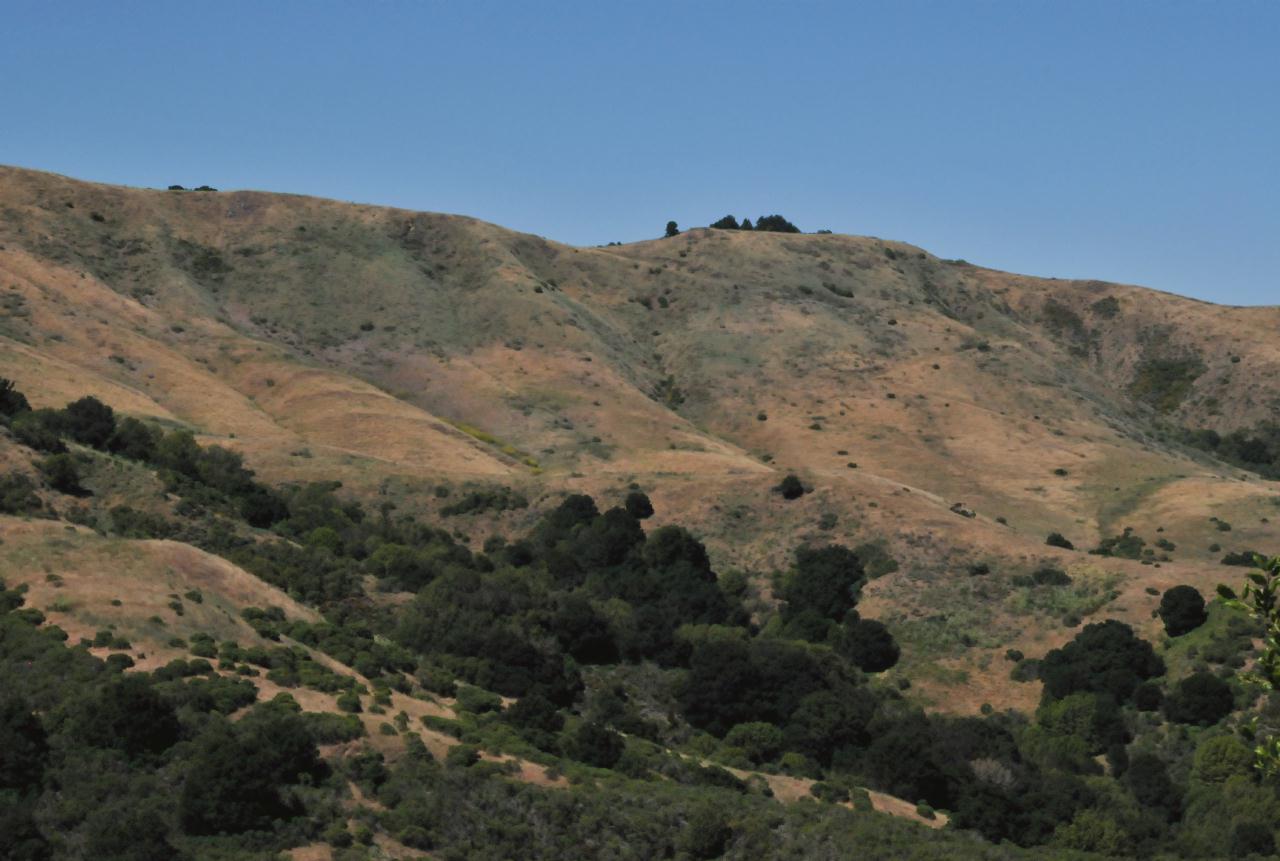 Near the trails end it once again attained a view of the East Bay hills.
Huckleberry Botanic Regional Preserve • East Bay Regional Parks District • Skyline Boulevard, Oakland, California • (Photo posted Tuesday 9 November 2010) • (Photo taken 15:37:38 Saturday 12 June 2010) • © 2010 Bryan Costales 
 #153738_6375BCX #153738_6375BCX
Add a comment or report a mistake
|
|
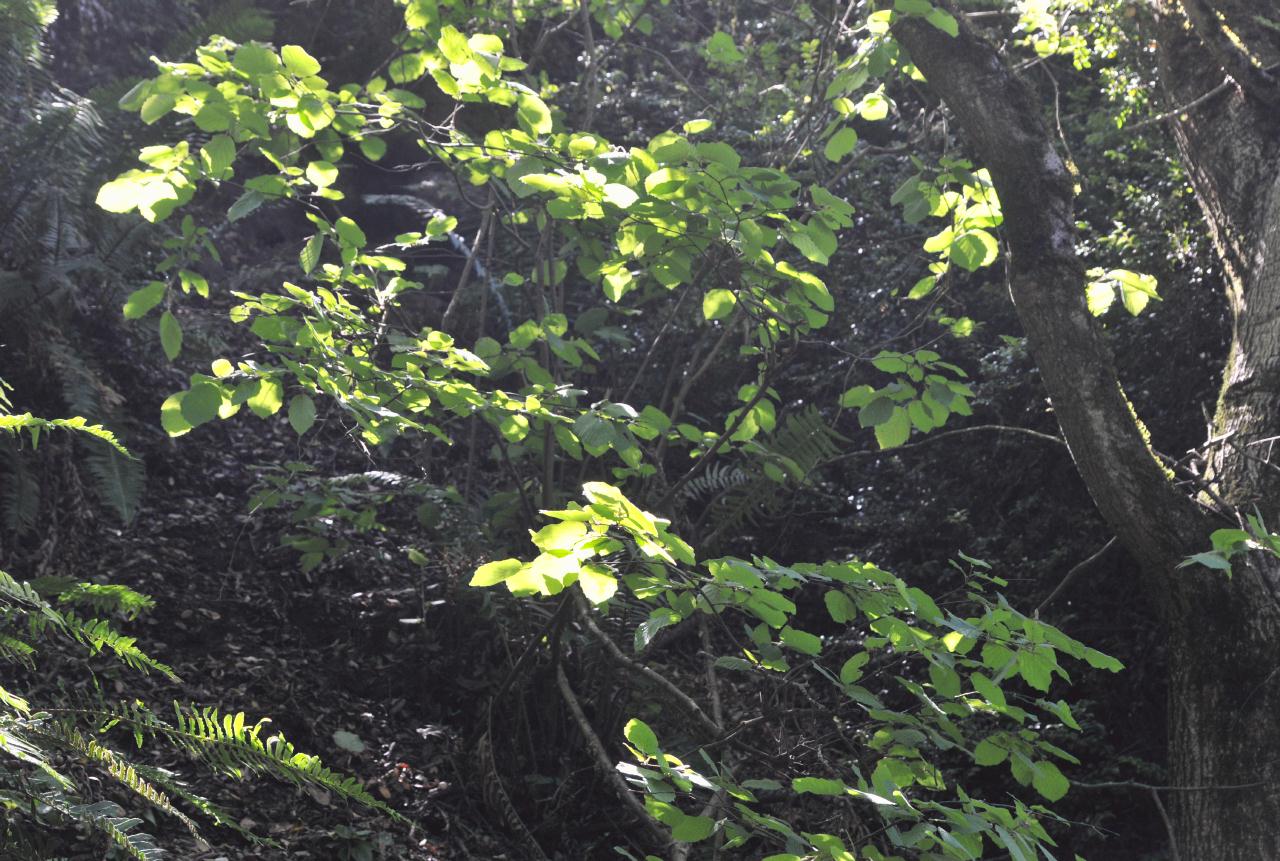
Coast Silktassel
Self-Guided Trail post #16 • Huckleberry Botanic Regional Preserve • East Bay Regional Parks District • Skyline Boulevard, Oakland, California • (Photo posted Tuesday 9 November 2010) • (Photo taken 15:45:04 Saturday 12 June 2010) • © 2010 Bryan Costales 
 #154504_6391BCX #154504_6391BCX
Add a comment or report a mistake
|
|
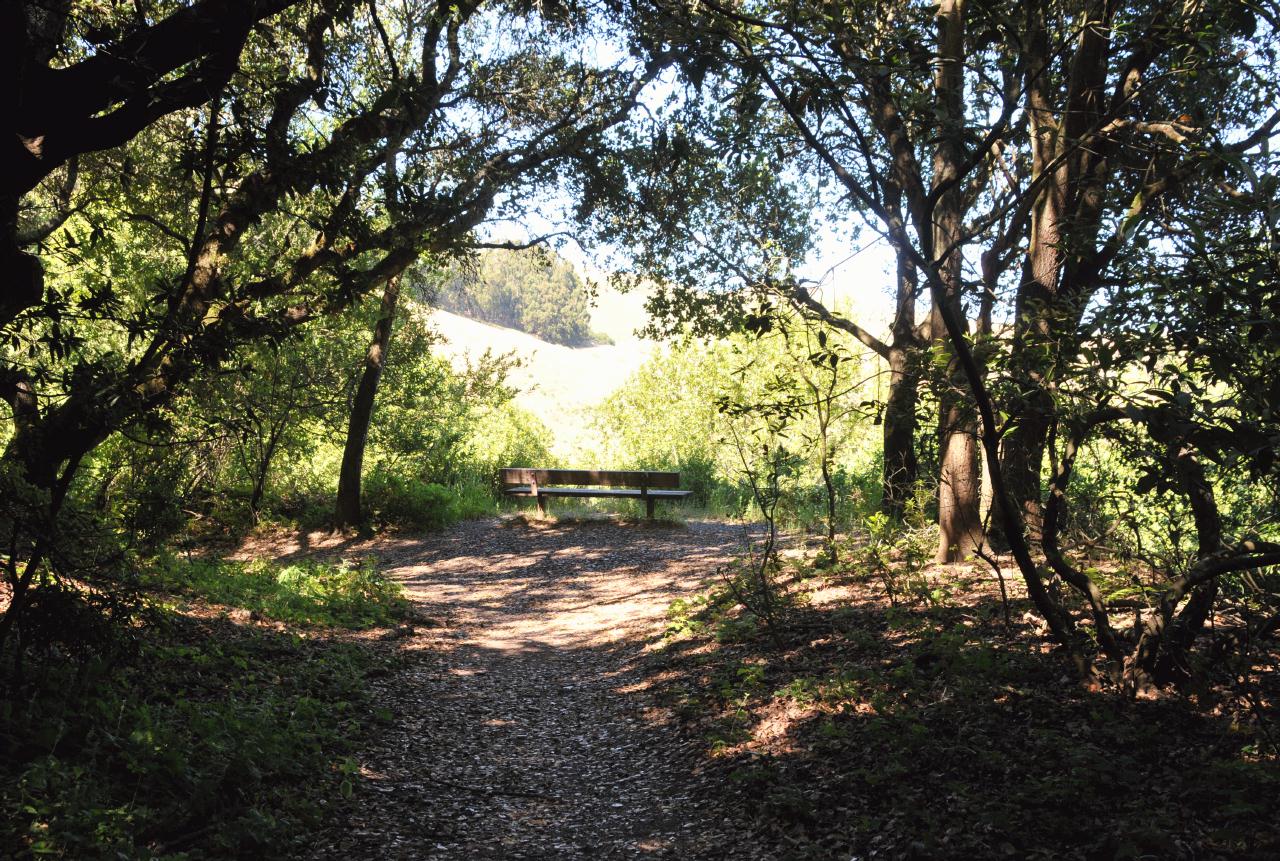 A bench appeared along the path. The bench afforded a view of the surrounding hills.
Huckleberry Botanic Regional Preserve • East Bay Regional Parks District • Skyline Boulevard, Oakland, California • (Photo posted Tuesday 9 November 2010) • (Photo taken 15:48:40 Saturday 12 June 2010) • © 2010 Bryan Costales 
 #154840_6392BCX #154840_6392BCX
Add a comment or report a mistake
|
|
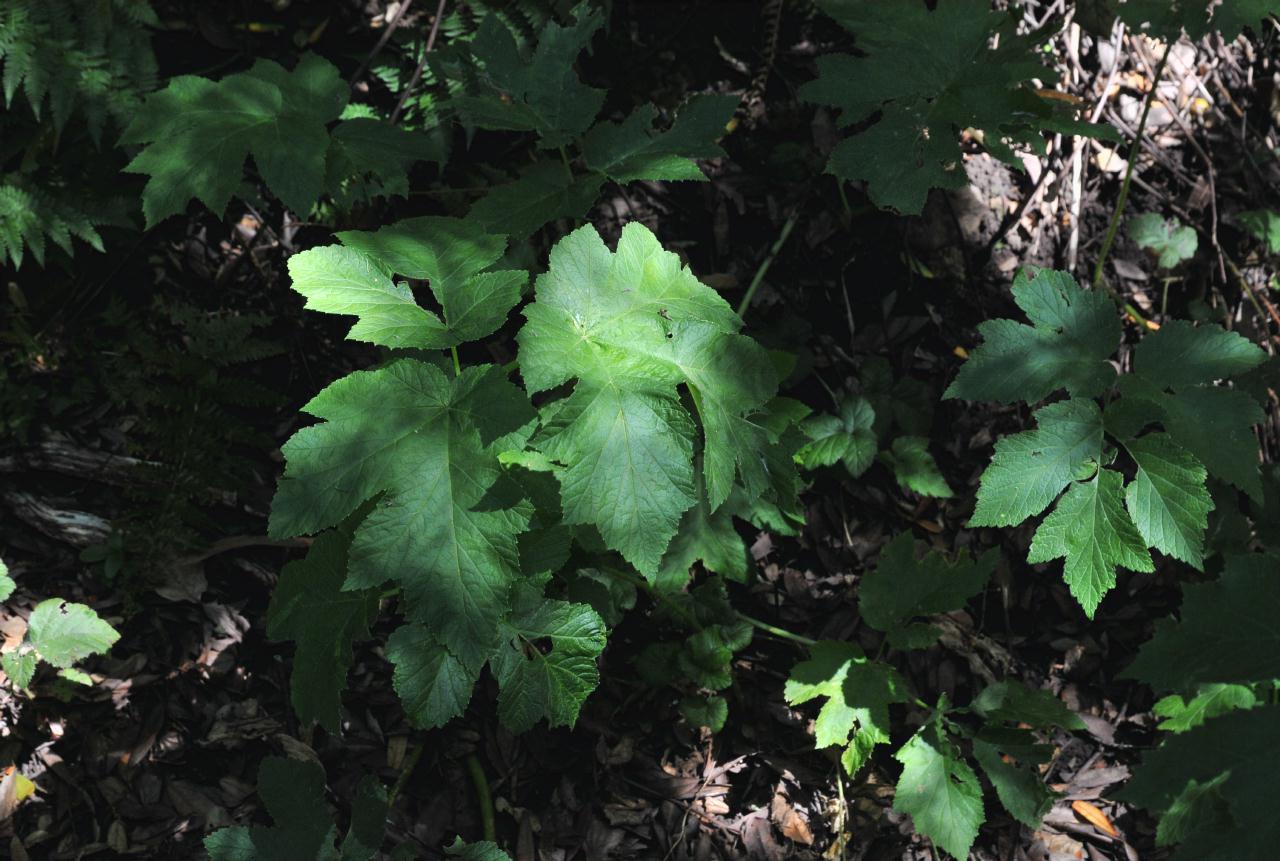 Pink-flowering Currant (Ribes glutinosum) was the last numbered plant stop on the trail. In mid-summer, it was no longer flowering. Self-Guided Trail post #17 Huckleberry Botanic Regional Preserve • East Bay Regional Parks District • Skyline Boulevard, Oakland, California • (Photo posted Tuesday 9 November 2010) • (Photo taken 15:57:17 Saturday 12 June 2010) • © 2010 Bryan Costales 
 #155717_6396BCX #155717_6396BCX
Add a comment or report a mistake
|
 |
| home • contact • topic guide • top 25 • photos • video • writing • blogs • upload • terms • privacy |